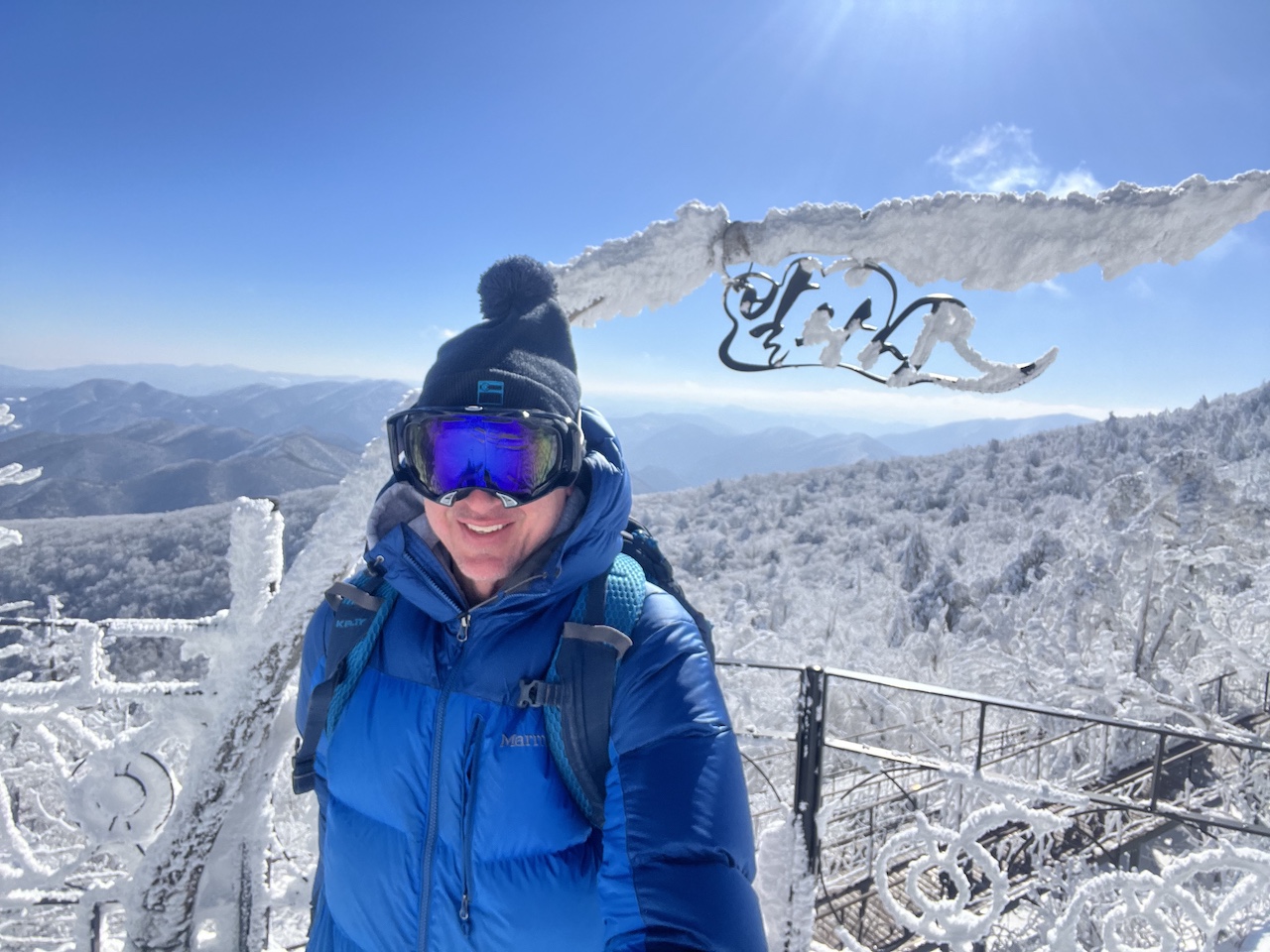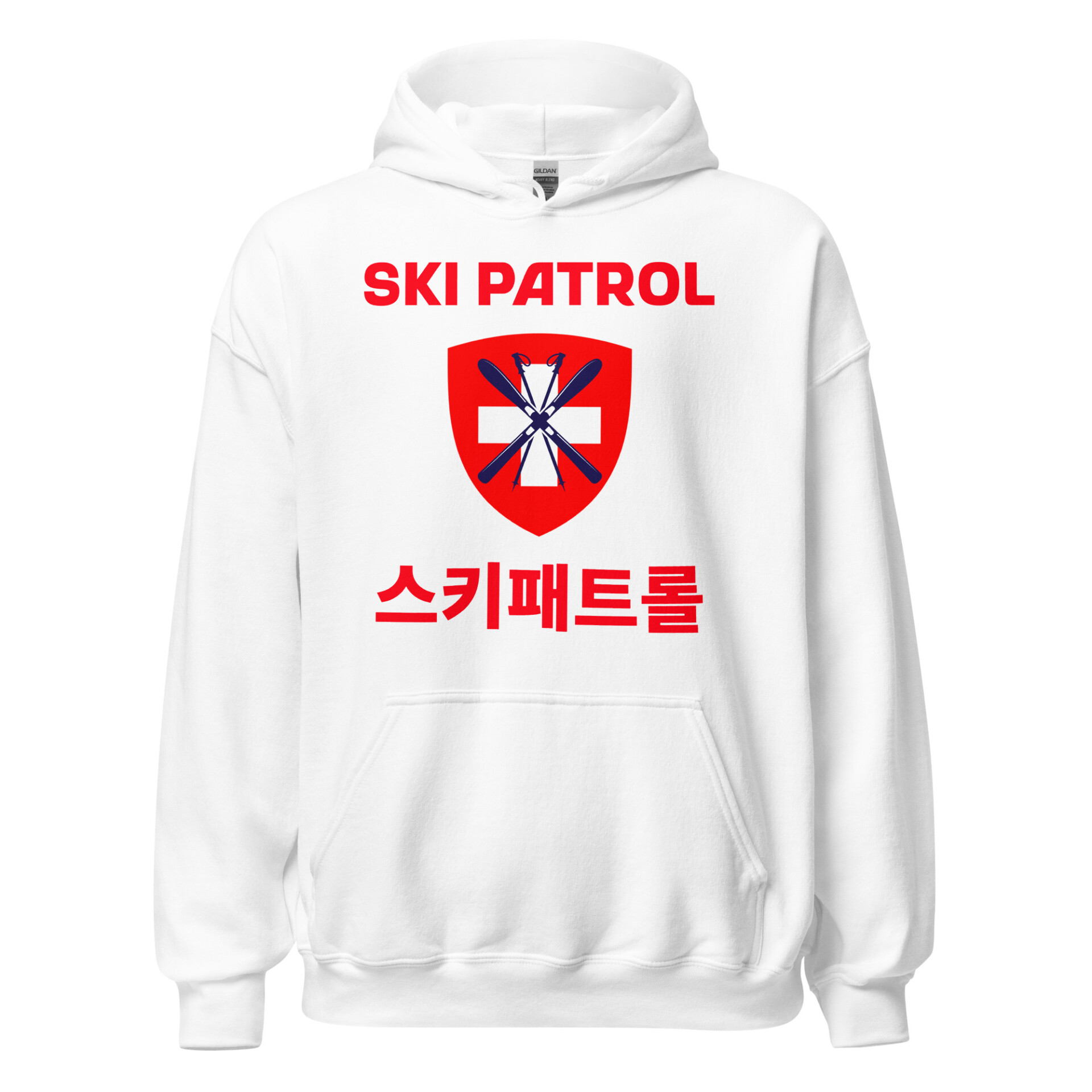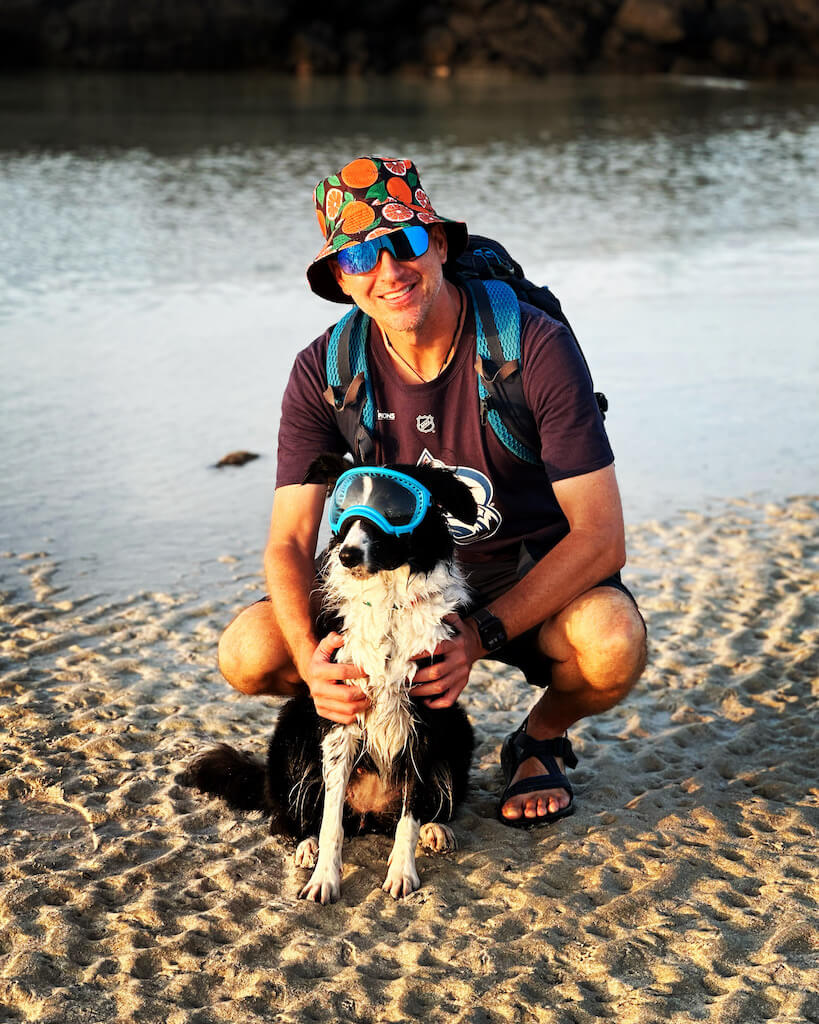Looking for the best ski resort in South Korea? Yongpyong Resort, also known as Mona Yongpyong, offers the country’s most advanced terrain, Olympic legacy slopes, and a layout that feels more like a Western mountain. In this guide, I’ll break down everything you need to plan your trip, from lift tickets and terrain zones to rentals, lodging, and local travel tips.
Quick heads up: This post may contain affiliate links to gear, hotels, flights, or experiences I’ve used — or genuinely recommend. If you book through one, I may earn a commission at no extra cost to you. Full disclosure here.
⛷️ What’s the Best Ski Resort in South Korea?
It’s one of the most common questions I get. While there are a few strong contenders, my answer usually comes down to two: High 1 and Yongpyong Resort.
If you’re after Korea’s steepest runs, Olympic legacy slopes, and a layout that feels more like a Western resort, Yongpyong is my top pick.
Locals and expats (myself included) still call it Yongpyong, but the official name these days is Mona Yongpyong Resort. Name aside, this is South Korea’s largest and best-known ski area, and it hosted the alpine events during the 2018 Winter Olympics.
I’ve been skiing since I could walk. I grew up in Vail, Colorado, and I’ve lived in Korea since 2007. After more than 15 seasons here, I can confidently say the Rainbow and Gold Zones at Yongpyong offer some of the most exciting terrain in the country for advanced skiers. That said, there’s plenty for beginners and families as well.
Whether you’re planning a ski trip to Korea or just looking for a weekend getaway, this guide covers everything you need: how to get there, where to stay, discounted lift tickets, and which zones to ride.
👉 Comparing resorts? Check out my full High 1 Resort guide. It’s a strong runner-up, but Yongpyong still takes the crown when it comes to expert terrain.
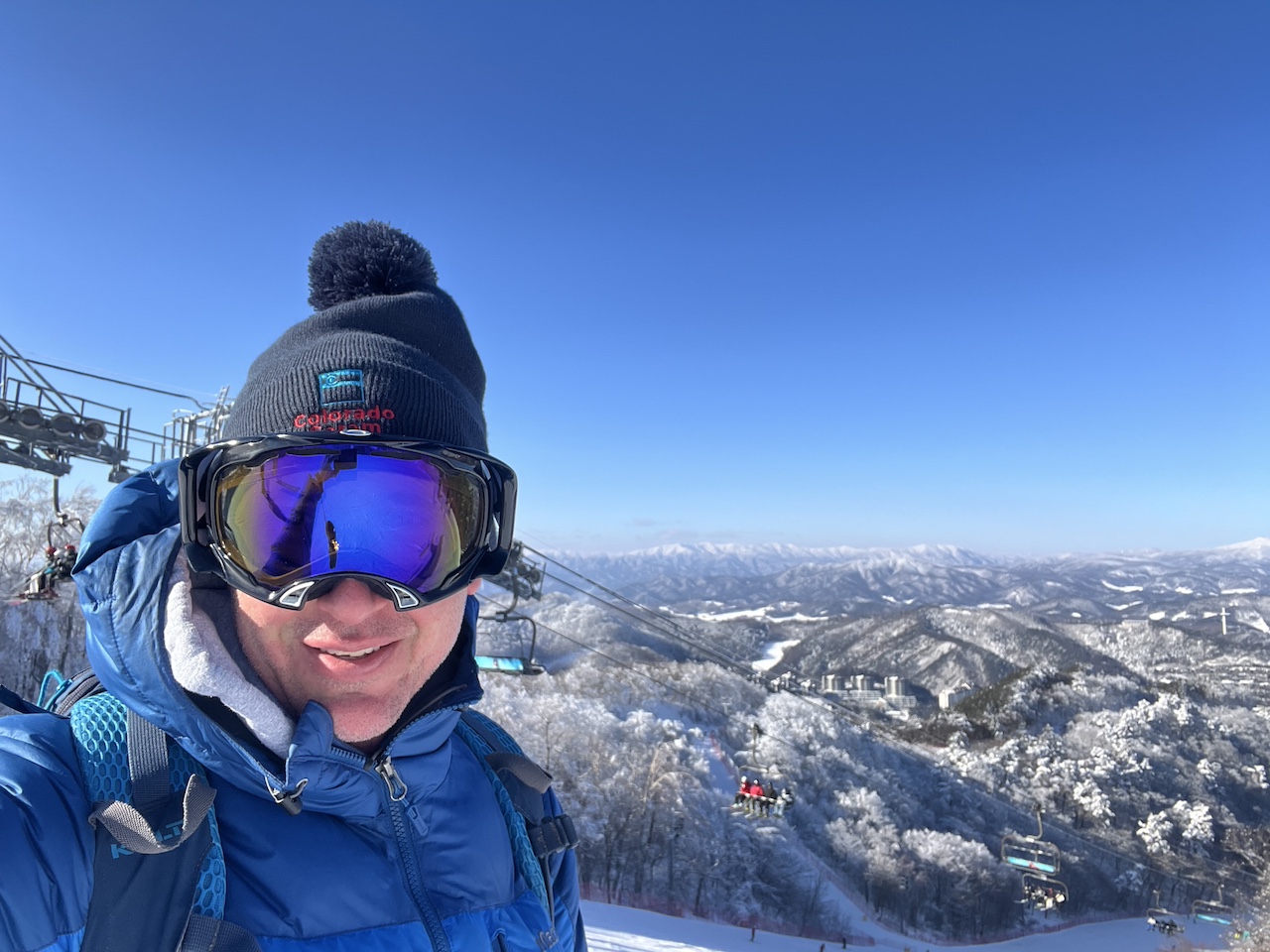
🆕 Updated for the 2025/26 Season:
This guide is based on my firsthand experience skiing Yongpyong over the past 15+ seasons, including my most recent visit in January 2025.
Key details like lodging, transportation, rentals, and lift tickets have been refreshed for the upcoming 2025/26 ski season, as much as possible at the time of writing. I’ll continue checking for official pricing and update this guide as new info becomes available.
🗺️ Where Is Yongpyong Resort Located?
Yongpyong Resort, officially known as Mona Yongpyong Resort, sits in Gangwon-do, a mountainous province in northeastern South Korea. The closest major city is Pyeongchang, home to the 2018 Winter Olympics, and the gateway to Korea’s most well-known ski slopes.
🏔️ Gangwon-do: Korea’s Mountain Playground
Gangwon Province (or Gangwon-do) is South Korea’s top destination for skiing and snowboarding. With its rugged terrain, colder climate, and relatively high elevation, it sees more snow than anywhere else in the country, though it won’t rival Colorado or Hokkaido anytime soon.
As a Colorado native, I still appreciate Gangwon’s charm. The region doesn’t just offer winter sports, it’s also a year-round haven for trekking, camping, and scenic road trips.
📍 Related: Year-Round Trekking and Camping in Daegwallyeong
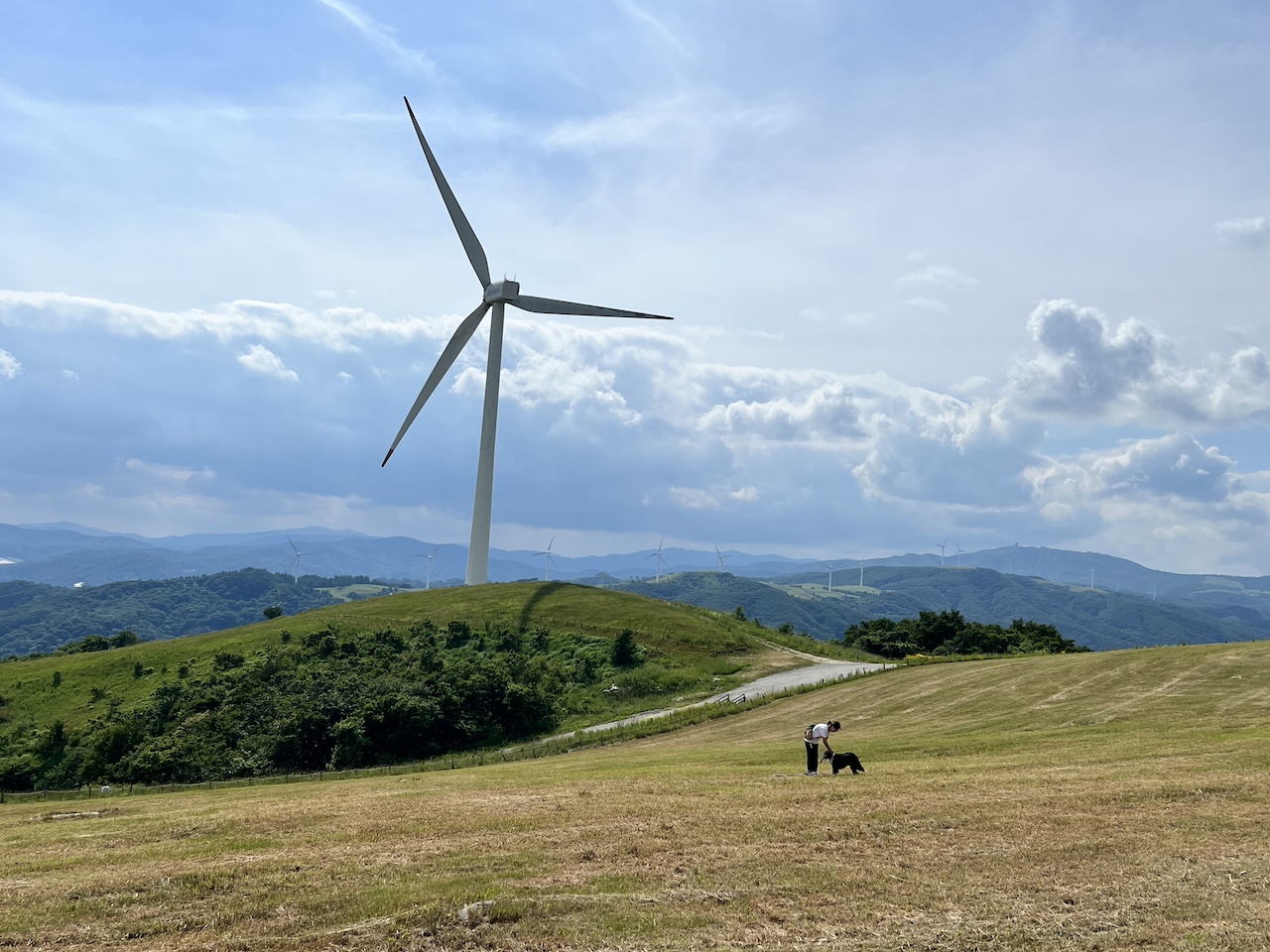
🏡 Pyeongchang: Gateway to the Slopes
Pyeongchang is a small city just a short drive from Yongpyong Resort. It hosted much of the 2018 Winter Olympics and still carries that legacy with its upgraded infrastructure, sports venues, and hotels.
The town itself is peaceful, low-key and a nice place to unwind after a day on the slopes. You’ll find a mix of hotels, cafés, local restaurants, and a few cultural spots. It’s not a nightlife hub, but that’s part of the appeal.
If you’re driving from Pyeongchang to Yongpyong, the ride takes about 30 minutes on well-maintained roads. You’ll also pass a long row of independent rental shops along the way and some of them offer better gear and discounted lift tickets compared to what’s available at the resort. (I’ll cover those later in the gear rental section.)

🚆 How to Get to Yongpyong Resort
Getting to Yongpyong Resort is relatively straightforward, whether you’re traveling by car, train, shuttle, or bus. The resort is located in Gangwon Province, near the town of Pyeongchang, and is well-connected to Seoul and Incheon International Airport.
Depending on your budget and travel style, here are the best ways to get there.
The simplest option? There’s a private transfer service from Klook that offers door-to-door rides from Incheon Airport or Seoul hotels directly to Yongpyong and other major resorts in Korea.
You’ll ride in a clean, comfortable vehicle with an English-speaking driver. It’s a perfect option for those looking to avoid the stress of luggage, public transit, or language barriers.
👉 Book your Yongpyong private transfer on Klook
🚗 By Car (Self-Drive or Rental)
Renting a car gives you the most flexibility, especially if you’re hauling ski gear, traveling with pets or kids, or planning to explore multiple resorts. Korea’s expressways are modern and easy to navigate, with English signage and reliable GPS via KakaoMap or Naver Map.
Most drivers from Seoul will follow this general route:
Gyeongbu Expressway (Highway 1) → Yeongdong Expressway (Highway 7) → Highway 4 East toward Jinbu and Daegwallyeong.
Estimated Drive Times:
- From Seoul: 2.5 to 3 hours
- From Daegu: Around 3.5 to 4 hours
- From Busan: Around 4.5 to 5 hours
📍 Navigation:
English: 715 Olympic-ro, Daegwallyeong-myeon, Pyeongchang-gun, Gangwon-do
Korean: 평창군 대관령면 올림픽로 715
🛣️ Related: Foreigner’s Guide to Driving in Korea
🚅 By Train (KTX to Jinbu Station)
The KTX bullet train is one of the fastest and most comfortable ways to get to Yongpyong Resort. From Seoul Station, you’ll head to Jinbu Station, which is the nearest KTX stop to the resort.
- Travel time: 1 hour 30 minutes to 1 hour 45 minutes
- Station: Jinbu Station (진부역) — not Pyeongchang Station
- Shuttle: Yongpyong offers a free shuttle bus for resort guests from Jinbu Station. It currently runs twice daily at approximately 11:00 a.m. and 3:00 p.m., but times may vary seasonally. Be sure to check or confirm in advance.
🎟️ You can book KTX tickets directly through Klook. It’s easier than navigating the Korail site in Korean, and you’ll have your reservation confirmed ahead of time.
🚌 Intercity Bus & Resort Shuttle Options
If you’re not driving or taking the train, intercity buses and private shuttles are another solid option.
Intercity Buses run from Dong Seoul Terminal or Express Bus Terminal in Seoul to Hoenggye or Jinbu, with onward transfers by local taxi or bus to Yongpyong.
Airport Shuttle: From Incheon International Airport, the Purple Ski Bus (operated by Grace Travel) offers direct service to Yongpyong in around 3 hours.
Seoul Shuttle: During winter season, Yongpyong operates dedicated shuttle buses from Seoul. Advance booking is usually required.
👉 Prefer a no-hassle ride from central Seoul?
This snow bus transfer to Yongpyong or Alpensia departs from four major pickup spots in the city and gets you to the slopes before noon. The drivers are experienced in navigating snowy roads, and round-trip service is available for a smooth return after your day on the mountain.
🎟️ Package Tours with Transport
If you prefer not to plan every leg of the trip yourself, package tours are a great option. I relied on them often before I had a car, and they’re especially helpful for beginners, families, or international visitors who want a stress-free experience.
You can find a variety of Yongpyong ski packages on Klook, including:
- 🎟️ Lift Ticket + Shuttle Bus from Seoul
- 🎿 Ski Gear Rental + Lift Pass Package
- 🛏️ 2D1N, 3D2N, or 4D3N Room & Ski Packages
Most depart from central Seoul, and the instructions are typically available in English.
📆 Seasonal Notes & Travel Tips
- Book early during peak season (late December to mid-February), especially around holidays.
- Weekday travel tends to be smoother, with less traffic and more shuttle availability.
- Shuttle times and resort buses can vary, so it’s always a good idea to confirm times a few days before your trip.
🎫 Lift Tickets & Hours (2025/26 Season Pending)
Yongpyong hasn’t released the official ticket prices for the 2025/26 season yet, but here’s what was listed for 2024/25. These rates give a solid idea of what to expect, especially early in the season when updates tend to be delayed.
| Ticket Type | Hours | Adult (14+) | Child (≤13) |
|---|---|---|---|
| Daytime | 09:00–17:00 | ₩95,000 | ₩77,000 |
| Morning or Afternoon | 09:00–13:00 / 13:00–17:00 | ₩67,000 | ₩55,000 |
| Afternoon + Night | 13:00–23:00 (Break 17:00–19:00) | ₩95,000 | ₩77,000 |
| Night | 19:00–23:00 | ₩67,000 | ₩55,000 |
| One-Time Pass | Single ride (lift/gondola) | ₩17,000 | ₩14,000 |
Note: These are 2024/25 prices. The resort hasn’t posted final rates for 2025/26 yet.
🕒 Operating Hours
- Day skiing: 09:00–17:00
- Night skiing: 19:00–23:00
- Afternoon + Night: 13:00–23:00
- Note: There’s typically a 2-hour break from 17:00–19:00 for grooming, restaffing, and maintenance.
🌜 Night Skiing and Snowboarding
Night skiing at Yongpyong typically runs until 11:00 p.m., with the full Afternoon + Night pass covering 1:00 to 11:00 p.m. (with a break between 5:00 and 7:00 p.m.).
While I usually prefer day sessions for visibility and snow quality, night skiing is a huge part of ski culture in Korea. Resorts stay open late, and the vibe under the lights is definitely something worth experiencing at least once.
🎥 The GoPro video below was filmed at High 1 Resort, but it gives you a good sense of what night skiing in Korea looks and feels like: bright lights, wide-open groomers, and a surprisingly energetic crowd for how late it gets.
💡 Insider Tips
- One-time gondola passes are great for scenic riders or non-skiers.
- Combo passes and online packages often skip the ticket lines and offer 20–25% discounts.
- Keep an eye out for gear rental + lift ticket bundles, especially on Klook or the resort’s site.
- Discounts rarely apply to one-time passes or peak-season weekends.
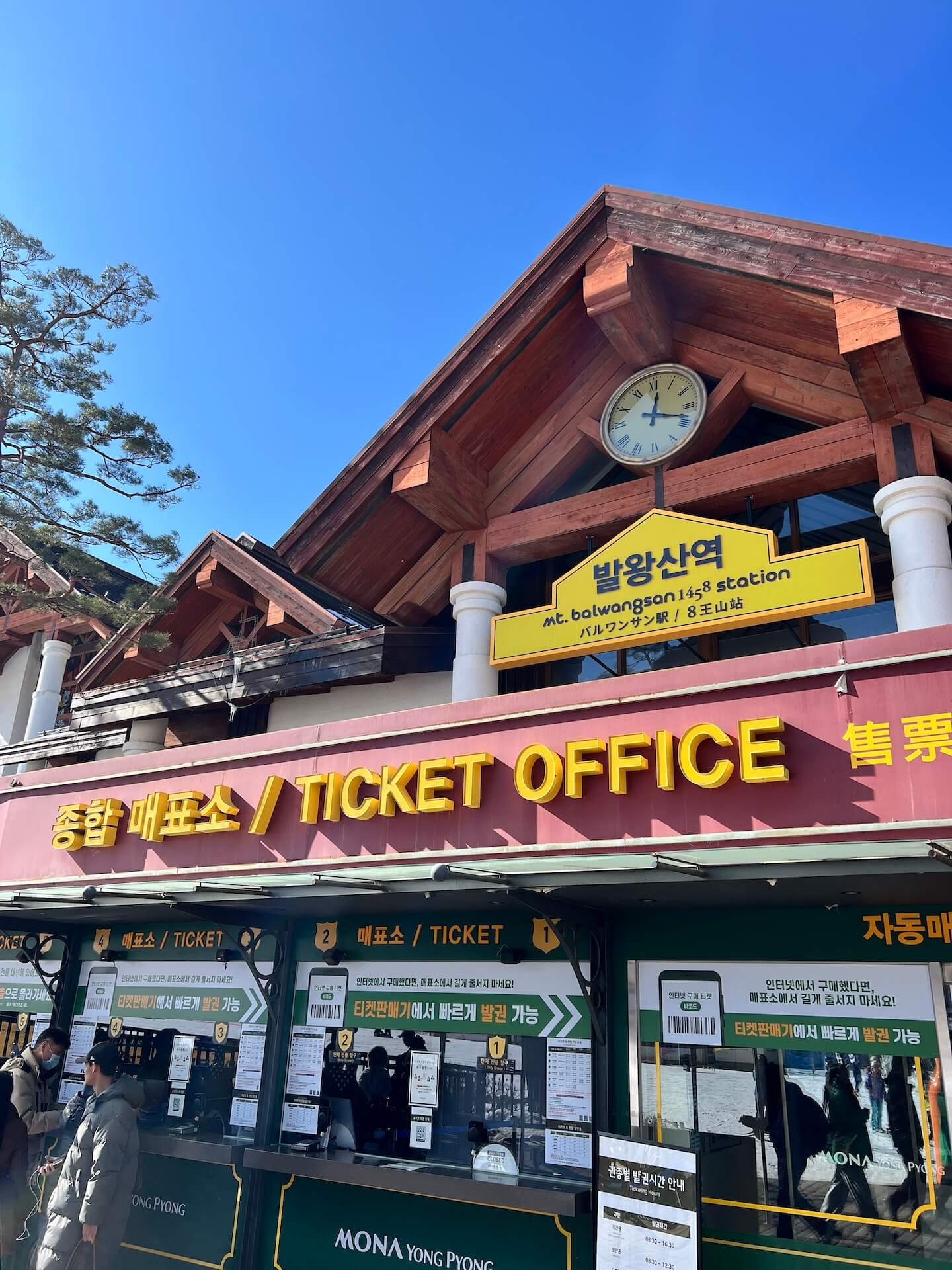
🗺️ Yongpyong Trail Map and Mountain Overview
Yongpyong Resort is the largest ski area in South Korea, with a layout that spreads across four main zones and 14 lifts. It offers a nice variety of runs for beginners, intermediates, and advanced skiers, though it’s best known for its Olympic-caliber steeps in the Rainbow Zone.
The vertical drop is around 740 meters (2,427 feet), with a summit elevation just under 1,500 meters. That’s fairly high for Korea and helps keep the snow in better condition longer into the season.
The mountain is split into four main ski zones, each served by its own base lodge and lift network:
- 🔴 Red Zone: Beginner-friendly and centrally located
- ⚪ Silver Zone: Terrain park, magic carpets, and ski school areas
- 🟡 Gold Zone: Intermediate to advanced carving runs
- 🟢 Rainbow Zone: Upper mountain expert terrain
A handful of connector trails and gondolas link the zones together, but the terrain layout makes it feel more like several mini resorts joined together, especially once you move beyond the lower slopes.
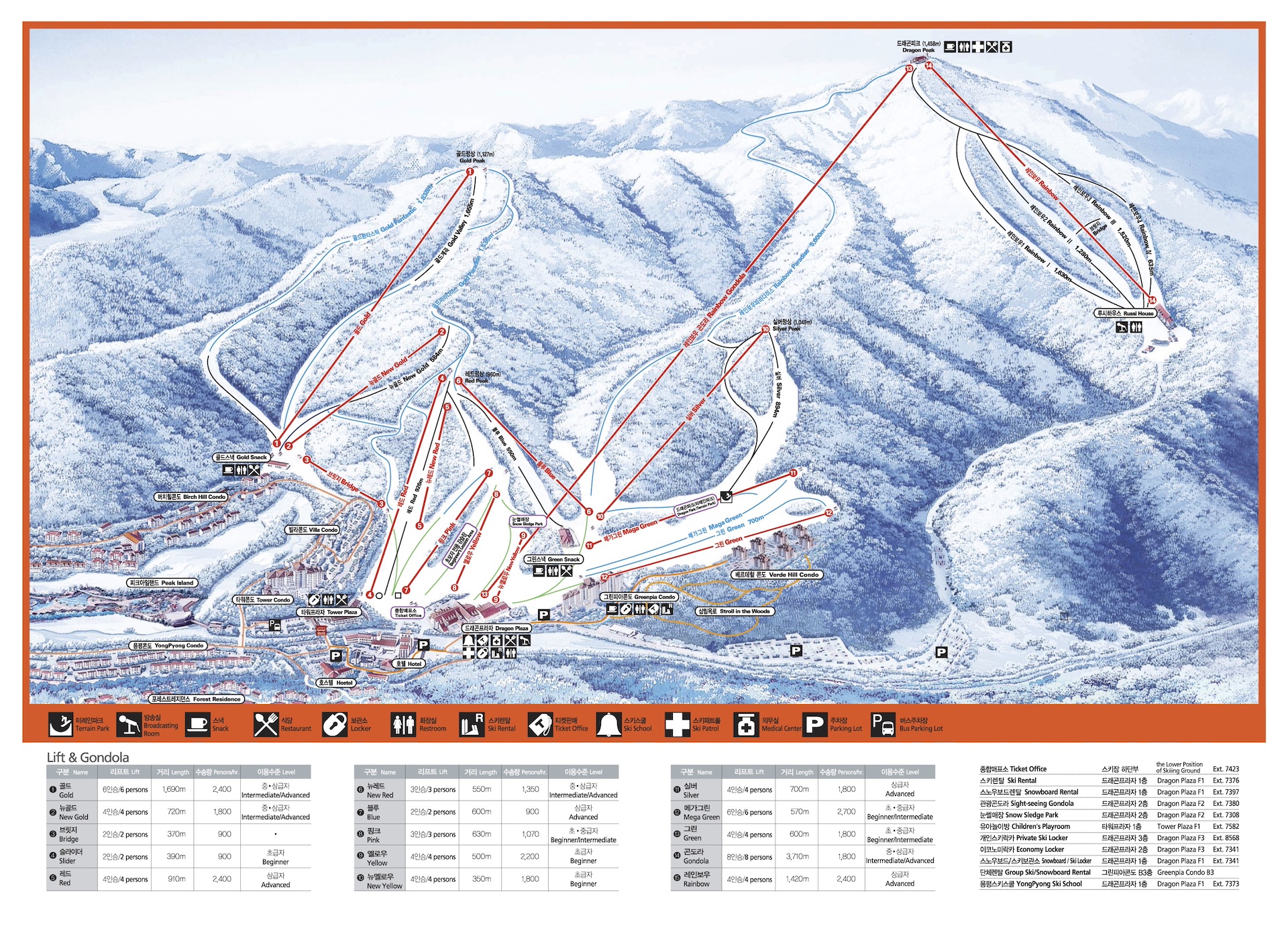
🏔️ Mountain Stats
- Summit elevation: 1,458 m (4,784 ft)
- Base elevation: 715 m (2,346 ft)
- Vertical drop: ~740 m (2,427 ft)
- Longest run: Rainbow Paradise (5.6 km / 3.5 miles)
- Total lifts: 14 (including gondolas and carpets)
- Total runs: 28 slopes
🚦 Terrain Breakdown
🚠 Rainbow Gondola (And Scenic Rides for Non-Skiers)
The Rainbow Gondola is one of Yongpyong’s main lifts, running from Dragon Plaza all the way up to the Rainbow Zone. It’s open to both skiers and non-skiers, and on clear days, it’s worth the ride for the views alone.
At the top, you’ll find sweeping views of the Taebaek Mountains, a small café, and access to Korea’s longest ski run (Rainbow Paradise). You can also ride the gondola back down if you’re not skiing from the summit.
If you’re visiting without ski gear, or just want to enjoy the mountain scenery, consider the Yongpyong Resort Balwangsan Cable Car & Skywalk Ticket. It includes a round-trip gondola ride and access to the upper-mountain skywalk near the summit. It’s a great option for families, non-skiers, or anyone visiting for the views.
📝 The gondola runs year-round, weather permitting, and is popular with hikers and tourists even outside of winter.
Dragon Peak & Dragon Castle
At the top of the Rainbow Gondola, you’ll find Dragon Castle, located in the scenic Mona Park. It’s a multi-level facility offering panoramic views and is bustling with activity. Skiers and snowboarders mingle with tourists who ride the gondola just for the views.
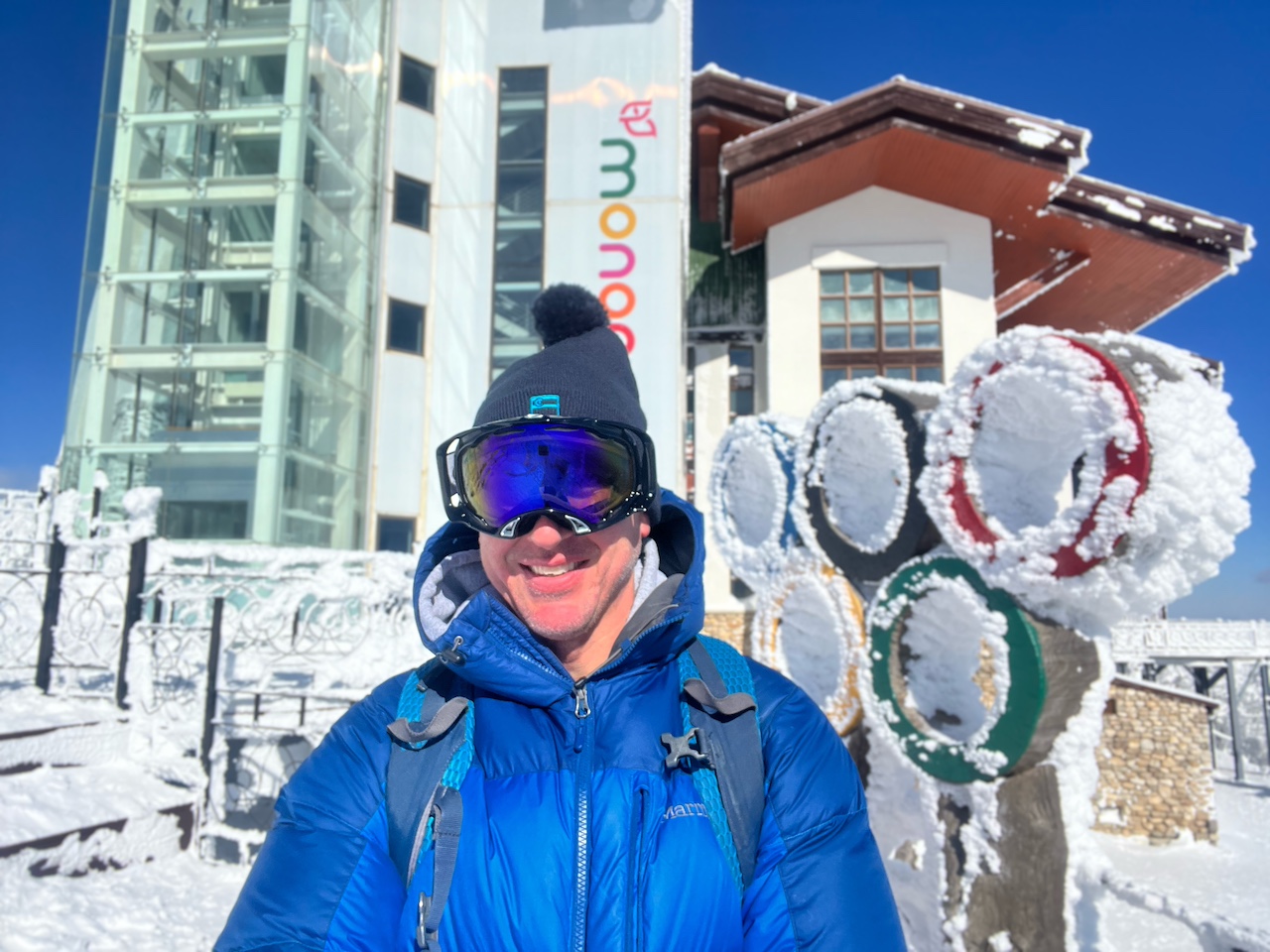
Inside, there are two restaurants and a café with large windows, giving you stunning mountain views as you dine. Outside, you can explore Olympic-themed photo areas and scenic viewpoints that offer breathtaking vistas of Gangwon-do’s mountains.
🗺️ Yongpyong Ski Zones: What to Know Before You Ride
If it’s your first time skiing here, it helps to think of Yongpyong as four mini-resorts. Each zone has its own vibe, terrain type, and lift access. Here’s a breakdown of each one, including which ones I actually ski, and which you might want to skip.
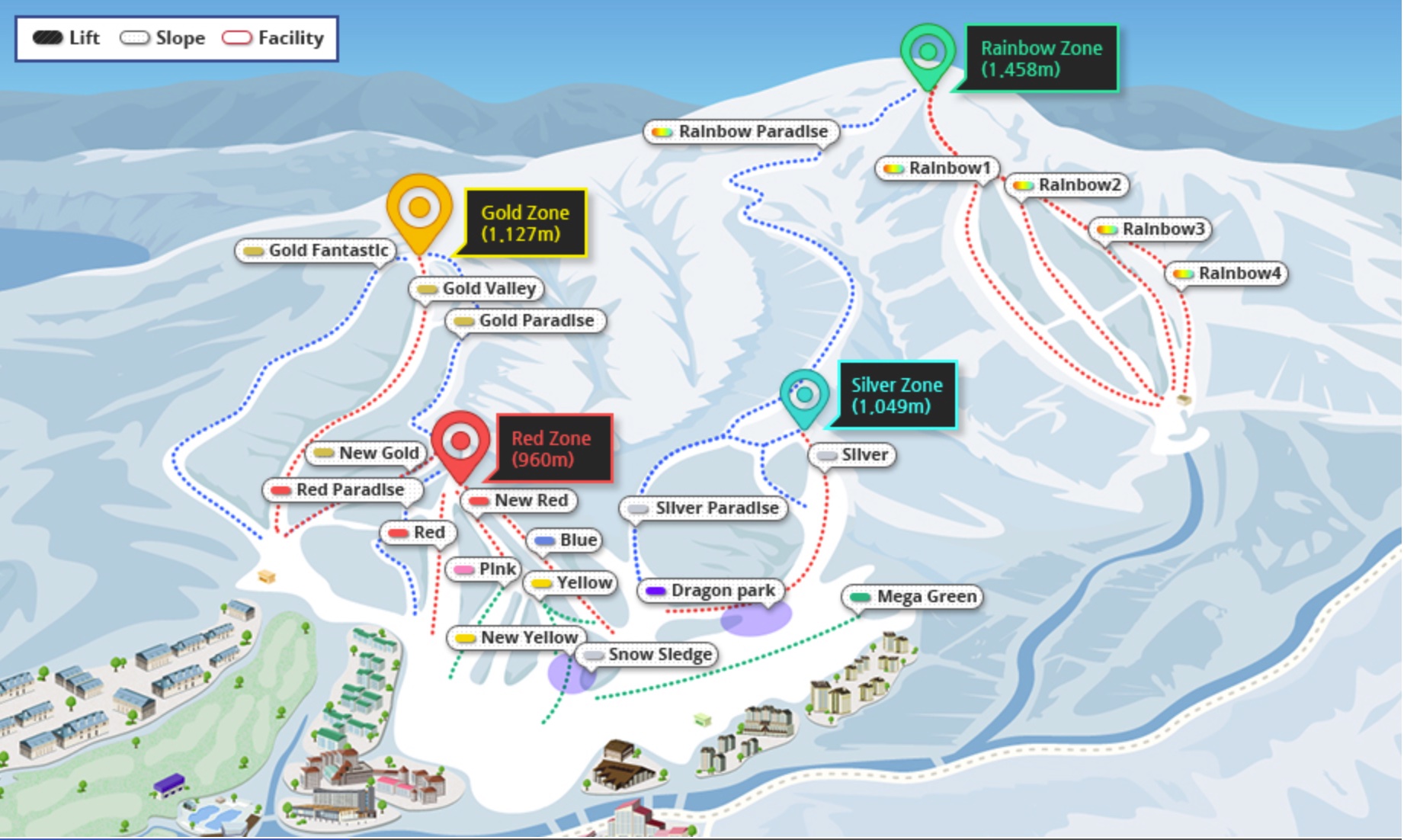
🟢 Rainbow Zone – Expert Terrain at the Summit
This is where I spend most of my time at Yongpyong. The Rainbow Zone sits at the top of the mountain and is home to the steepest runs and most legit expert terrain in the country. It’s also where the Olympic GS and slalom events were held during the 2018 Winter Games.
Best Runs:
- Rainbow 1 and 2: Long, fast groomers with solid pitch
- Rainbow Paradise: A winding 5.6 km cruiser that’s fun on fresh corduroy


🎥 Rainbow Zone POV: Full Top-to-Bottom Run
Want to see what the Rainbow Zone looks like from the top? Here’s a GoPro video I shot during a January 2025 visit. The snow wasn’t deep that day and the air was a little hazy, but the runs were wide open and perfect for fast, uninterrupted laps.
Notes:
- This zone is usually quiet, especially on weekdays
- You can lap it quickly if you park up top and avoid the lower zones entirely
- Best accessed via the Rainbow Gondola or Rainbow Chairlift
Parking Tip:
- There’s a small parking lot just up the road from the main Dragon Plaza area, near the Rainbow Zone base station. While Dragon Plaza can be crowded and chaotic, the Rainbow lot is usually mellow. It’s a great place to get booted and suited, just steps from the lifts.
Dog-Friendly Wag Village Base Lodge
At the base of the Rainbow Zone, you’ll also find Wag Village, a small pet-friendly lodge with outdoor benches, heaters, and a café-style setup that’s surprisingly welcoming to dogs. I’ve brought mine here a few times and it’s a quiet, scenic place to hang out between laps or take a break if you’re not skiing the whole day.
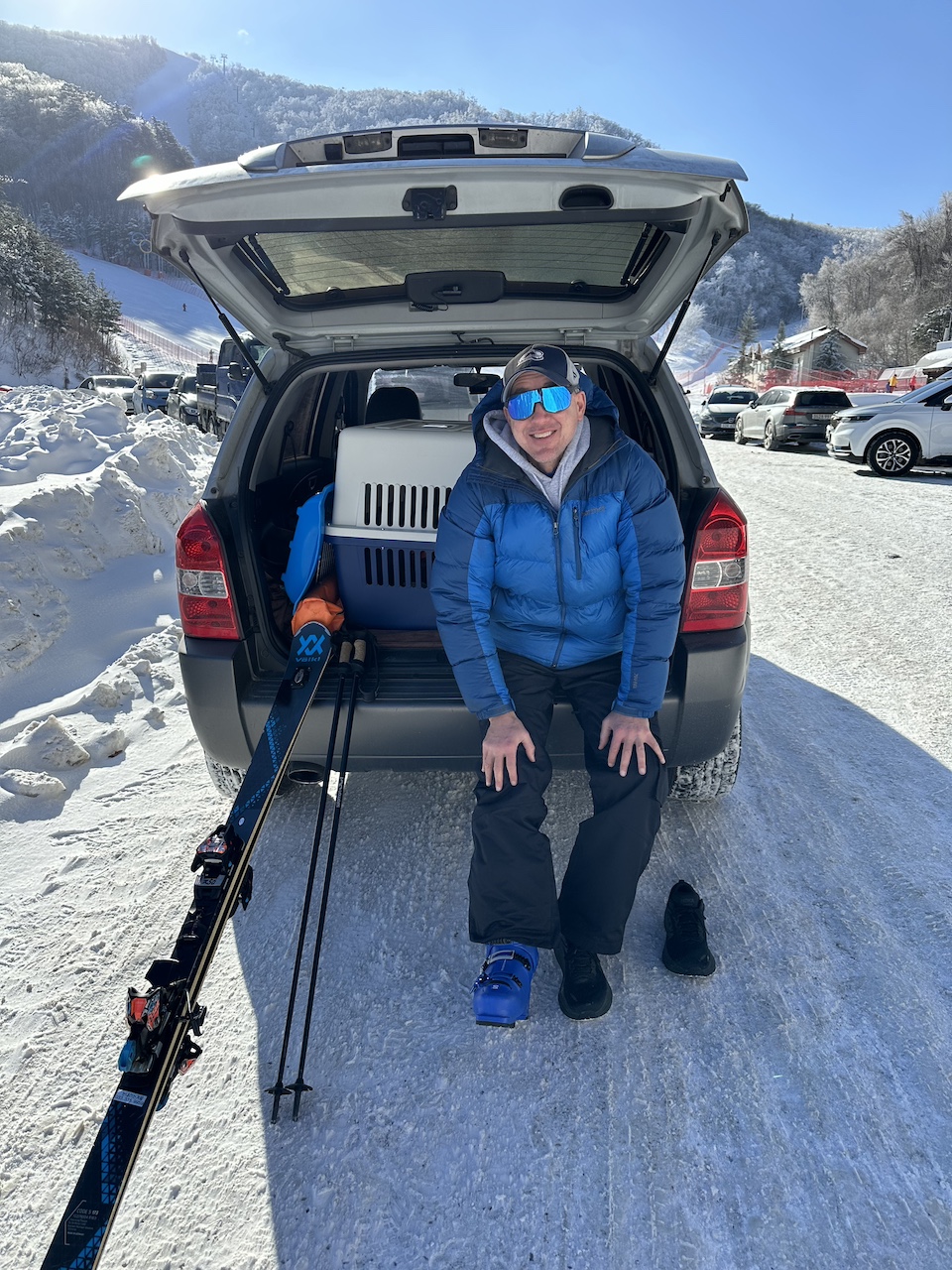

🎥 Making Turns on the Rainbow Zone
🟡 Gold Zone – Intermediate & Advanced Groomers
The Gold Zone sits just below Rainbow and has a solid mix of intermediate to advanced runs. It’s a favorite among local carvers and snowboarders who like wide, fast slopes.
Best Runs:
- Gold Valley: Good pitch, often has the best snow on the lower half
- Gold Paradise: A long intermediate trail that connects back to the primary base area
Base Lodge & Food:
- There’s a small base with restrooms and a cafeteria, but the options are limited compared to Dragon Plaza. It was previously known as Gold Snack, but recently changed it’s name to Anifore the Gold.
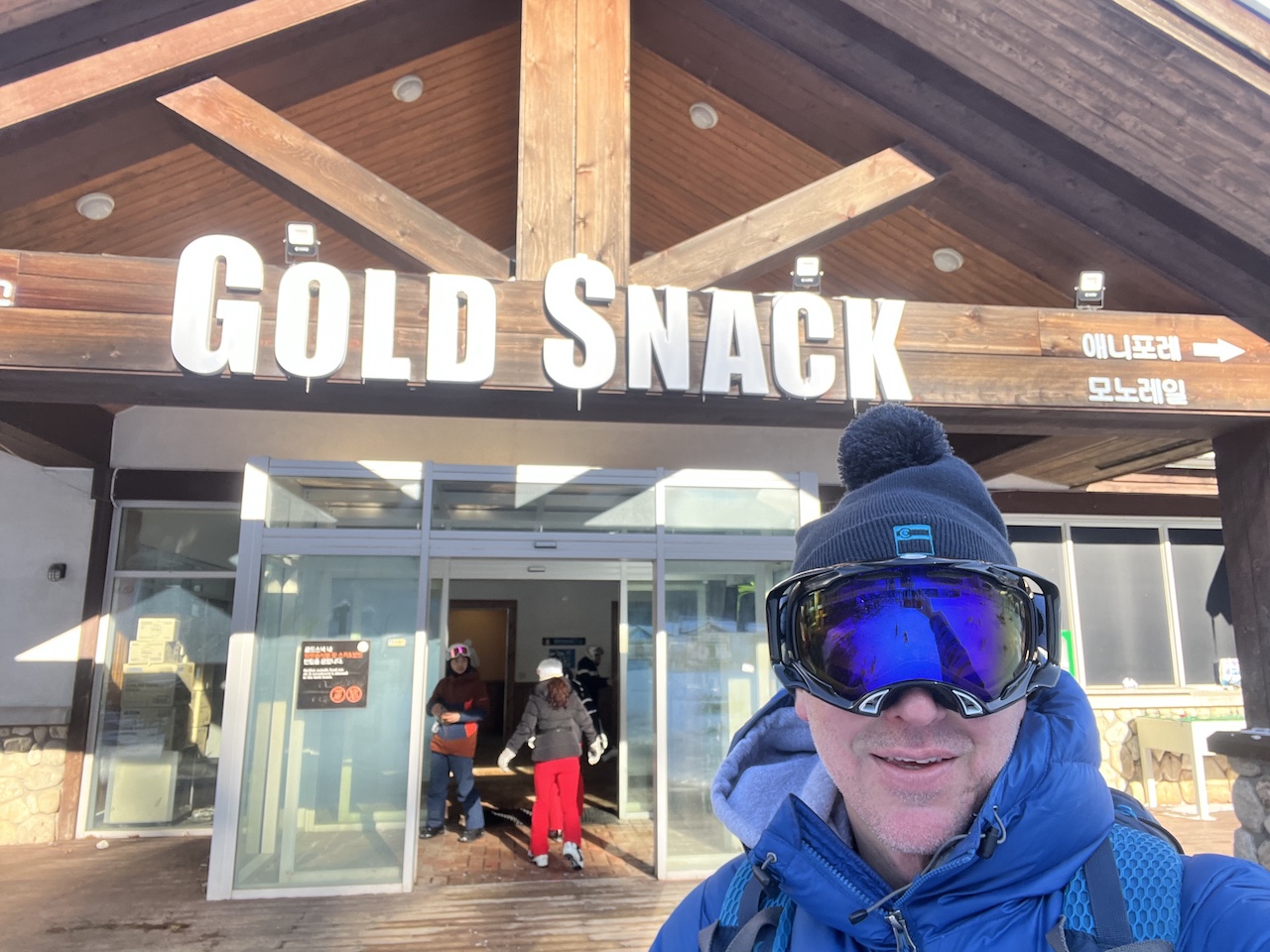
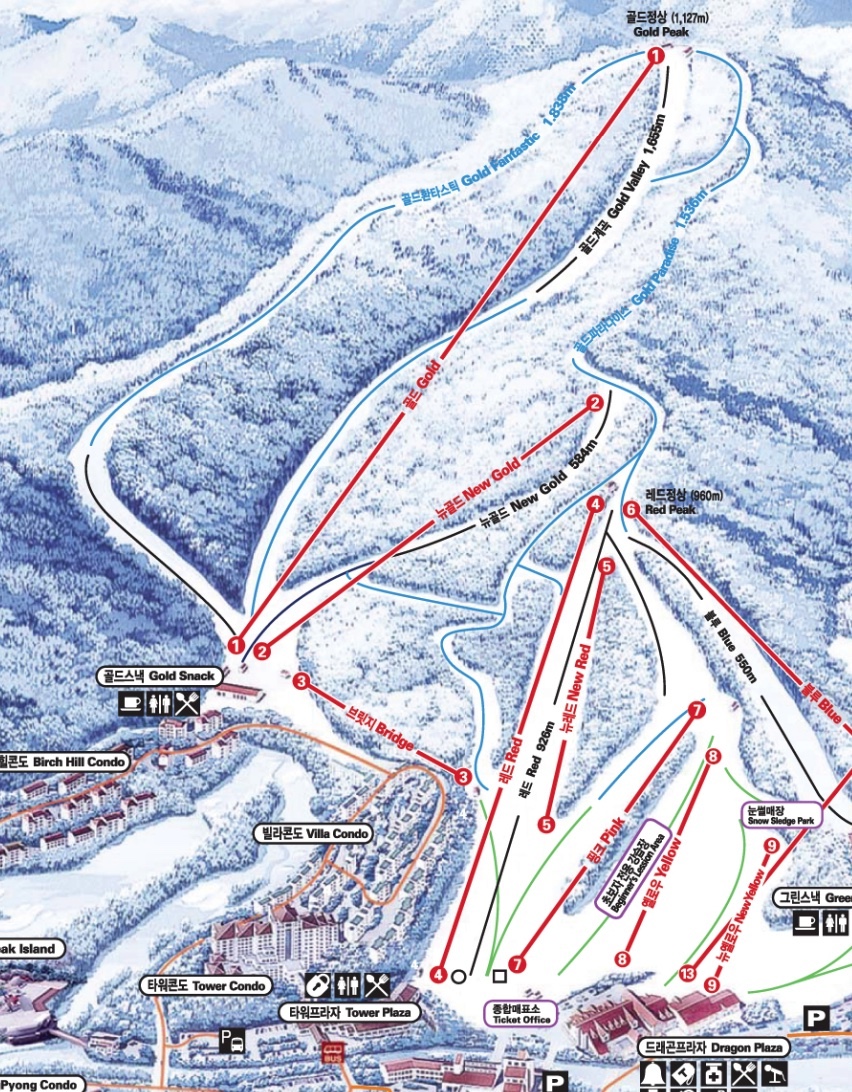
🎥 Gold Zone POV: Lower Section
🔴 Red Zone – Central and Beginner Friendly
This is the busiest and most crowded zone, especially on weekends. It’s also where the main base area (Dragon Plaza) is located, along with ski rentals, restaurants, and the bulk of the ski school activity.
Best For:
- First-timers, families, or those staying in on-site condos
- Skiers using the gondola for sightseeing or access to Gold
Pros:
- Quick access to lessons, rental shops, and cafés
- Closest to accommodation
Cons:
- Extremely crowded during peak weekends and holidays
- Not ideal for fast laps or advanced riders
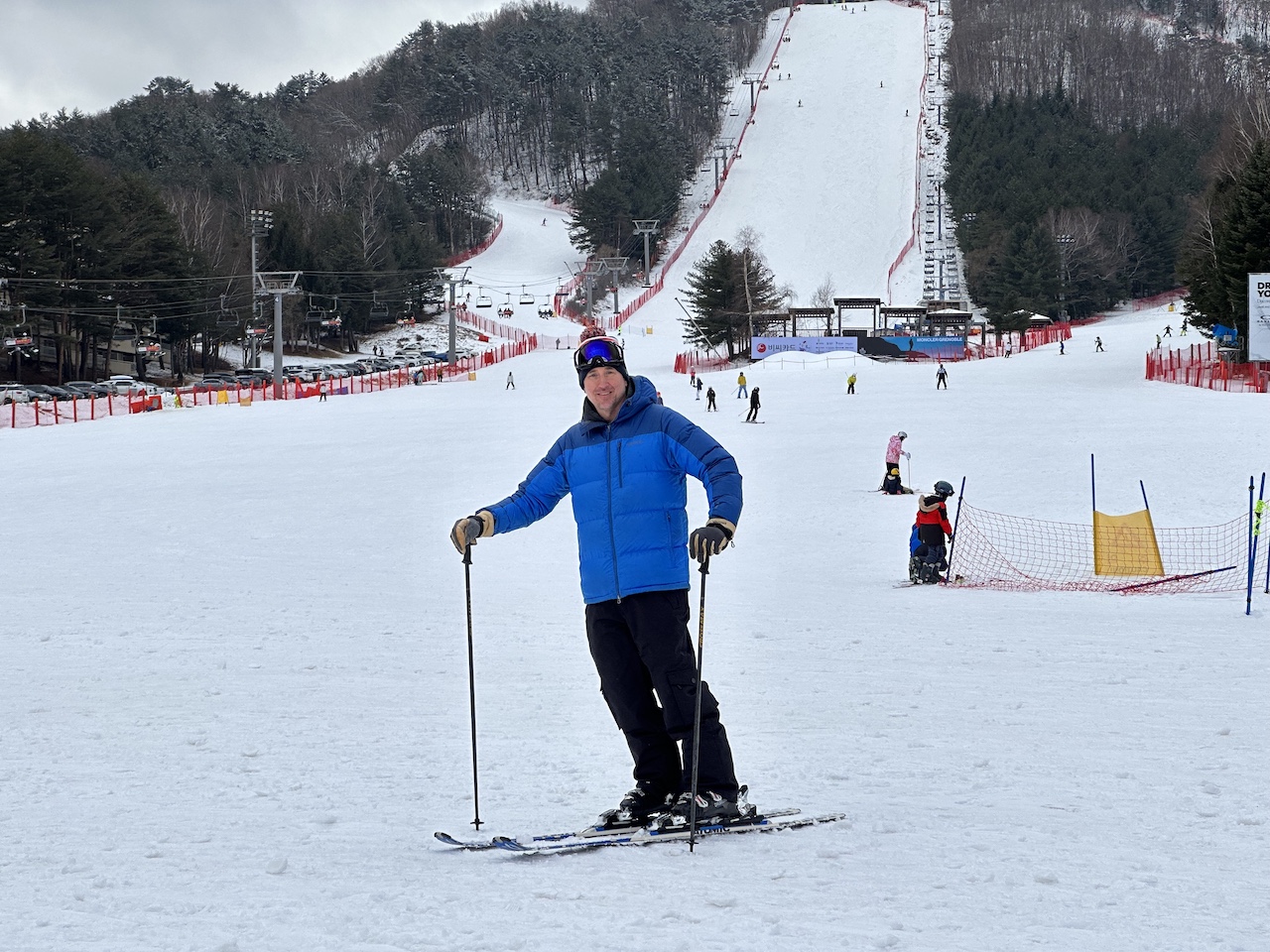
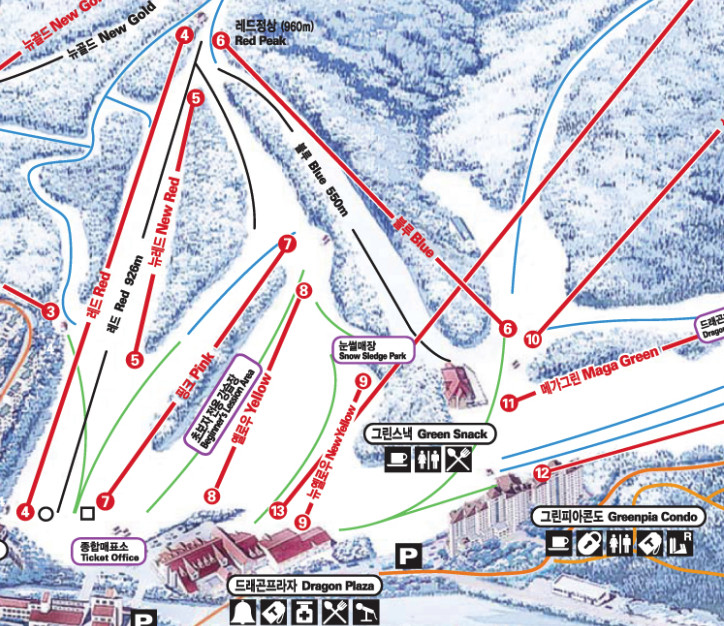
⚪ Silver Zone – the Dragon Park Terrain Park and Learning Areas
The Silver Zone is tucked off to one side of the resort and is best suited for true beginners or kids. It also hosts the terrain park, although depending on the season, that can be hit-or-miss in terms of features and maintenance.
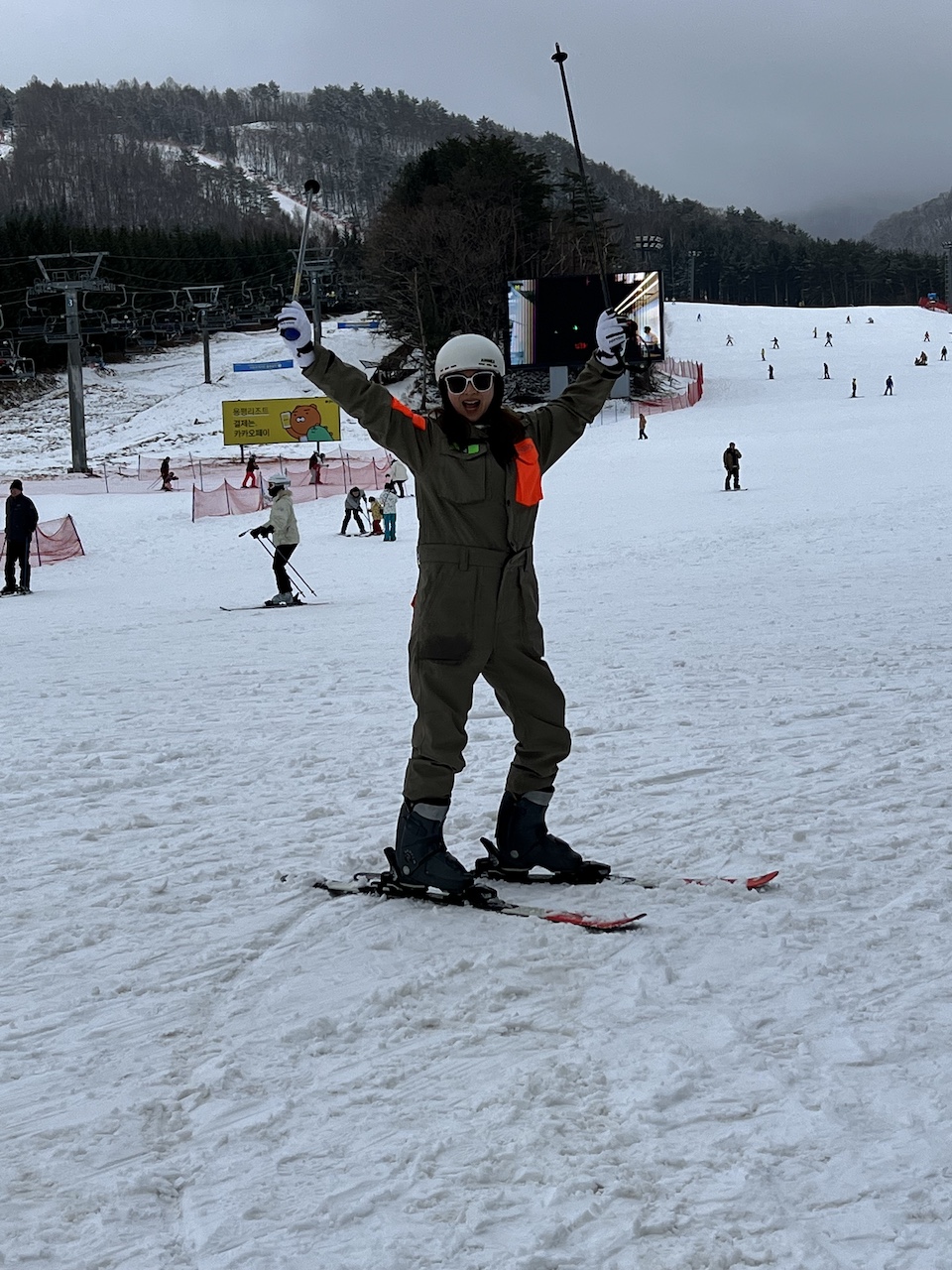
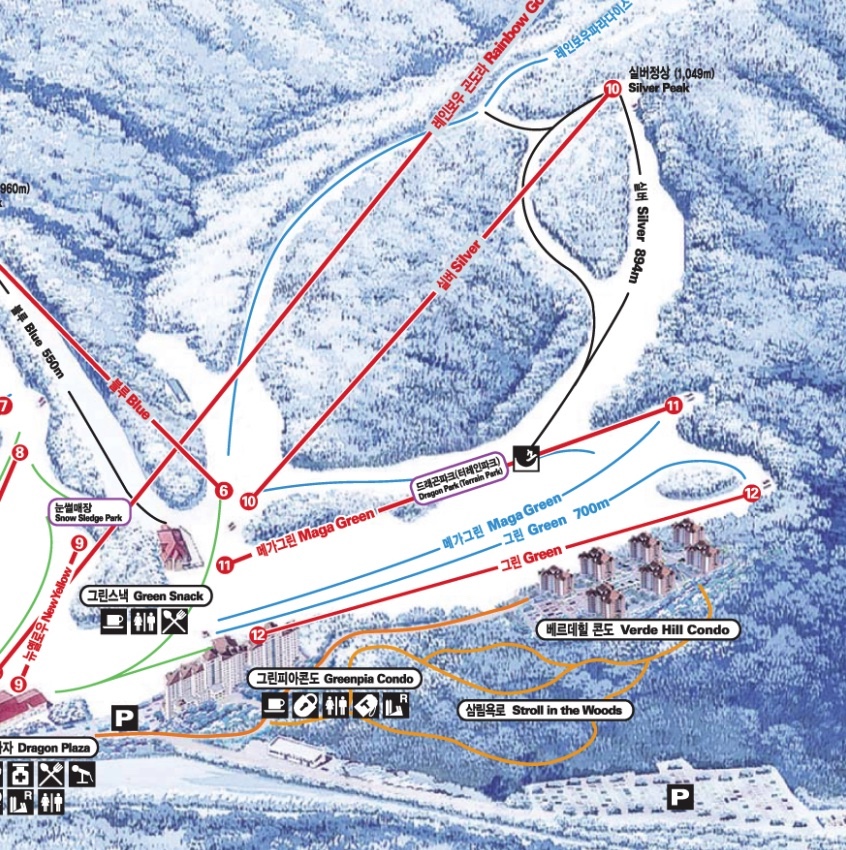
Features:
- Magic carpets and gentle inclines
- Terrain park with rails, kickers, and small jumps
- Ski school staging area
Dog-Friendly Tip:
- Some of the flatter areas here are good for walking dogs, especially in early morning or post-close hours. Just be mindful of signs and staff direction.
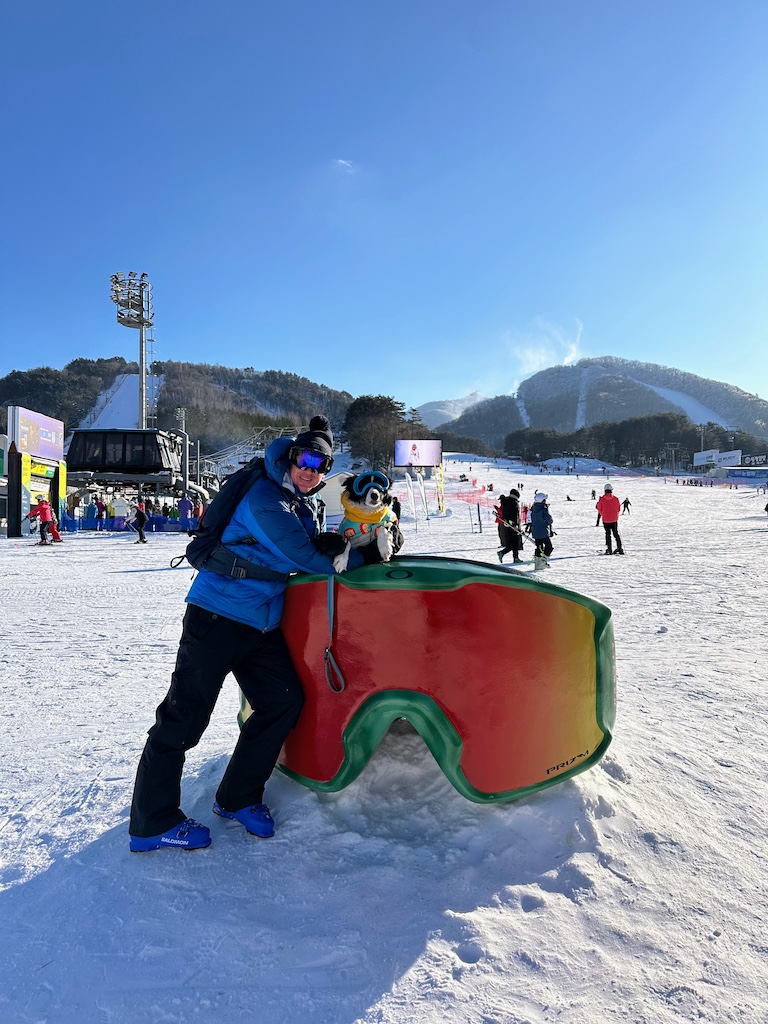
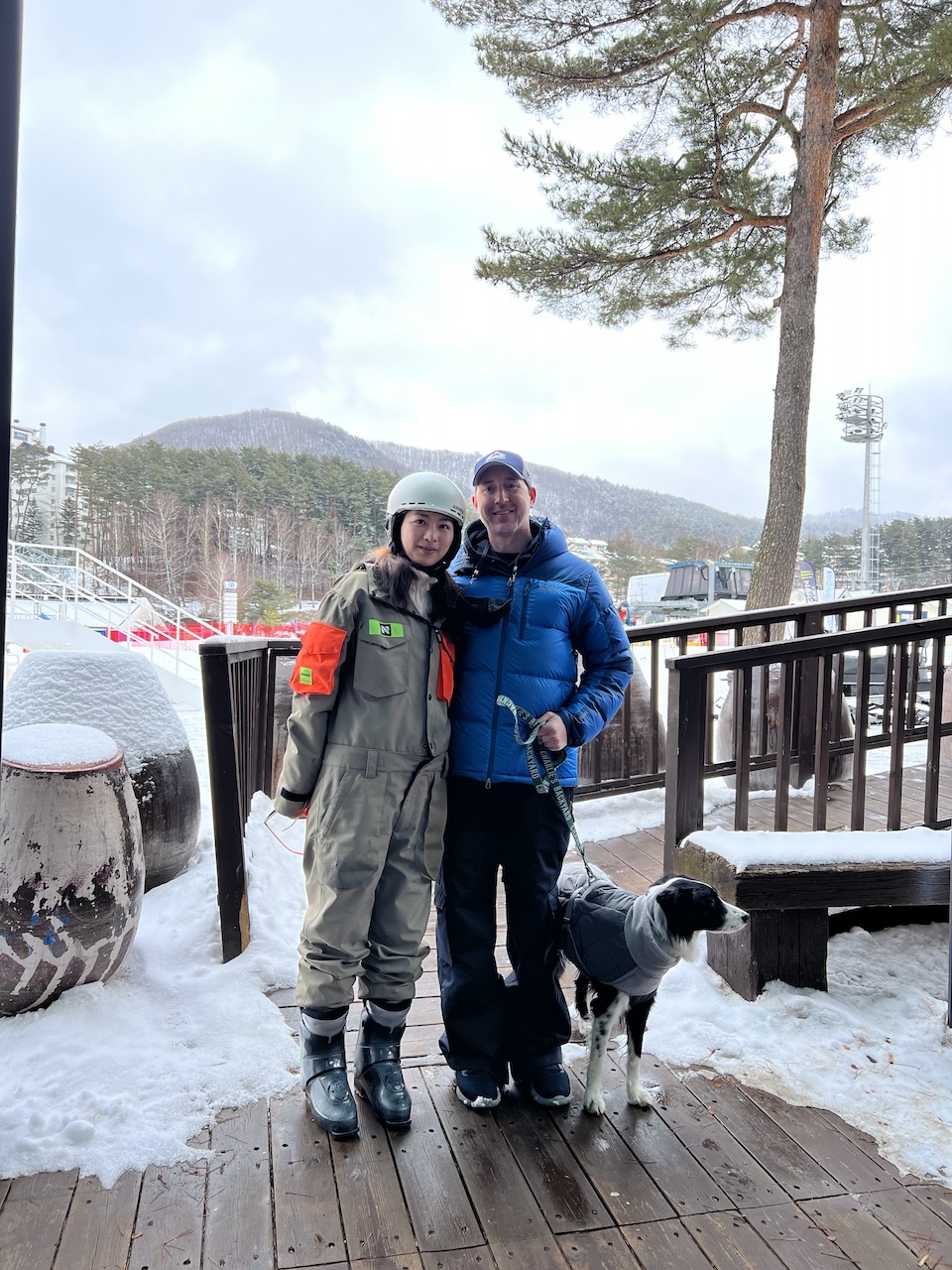
🎒 Where to Rent Skis & Snowboards at Yongpyong
You’ve got two main choices for ski and snowboard rentals: on-site at the resort, or off-site shops along the road from Pyeongchang. I’ve rented from both, and if you care about gear quality, you’ll want to read closely.
🏬 Option 1 – On-Site Rentals at Dragon Plaza
The main rental center at Yongpyong is located inside Dragon Plaza, the resort’s central base lodge. It’s the most convenient option by far, especially if you’re arriving by shuttle, staying at the resort, or just want a quick grab-and-go setup.
- Staff are efficient, English-friendly (enough), and the process is smooth
- Equipment is serviceable, but mostly entry-level and heavily used
- Limited selection of sizes for high-performance skis or wider boots
This is the best option for beginners, families, or short visits, but not ideal if you’re picky about your gear.
🚗 Option 2 – Off-Site Rental Shops in Pyeongchang
If you’re driving or don’t mind grabbing a taxi, the road from Pyeongchang town to Yongpyong is lined with independent rental shops. I’ve found better gear, lower prices, and more flexibility at these places.
- Some shops carry carving skis, powder boards, or newer demo gear
- You’ll often get a lift ticket + rental bundle for less than the resort charges
- Staff may speak limited English, but most shops are used to tourists
This is where I usually rent. I’ve even found high-quality carving skis here that matched what I’d expect at home in Colorado.
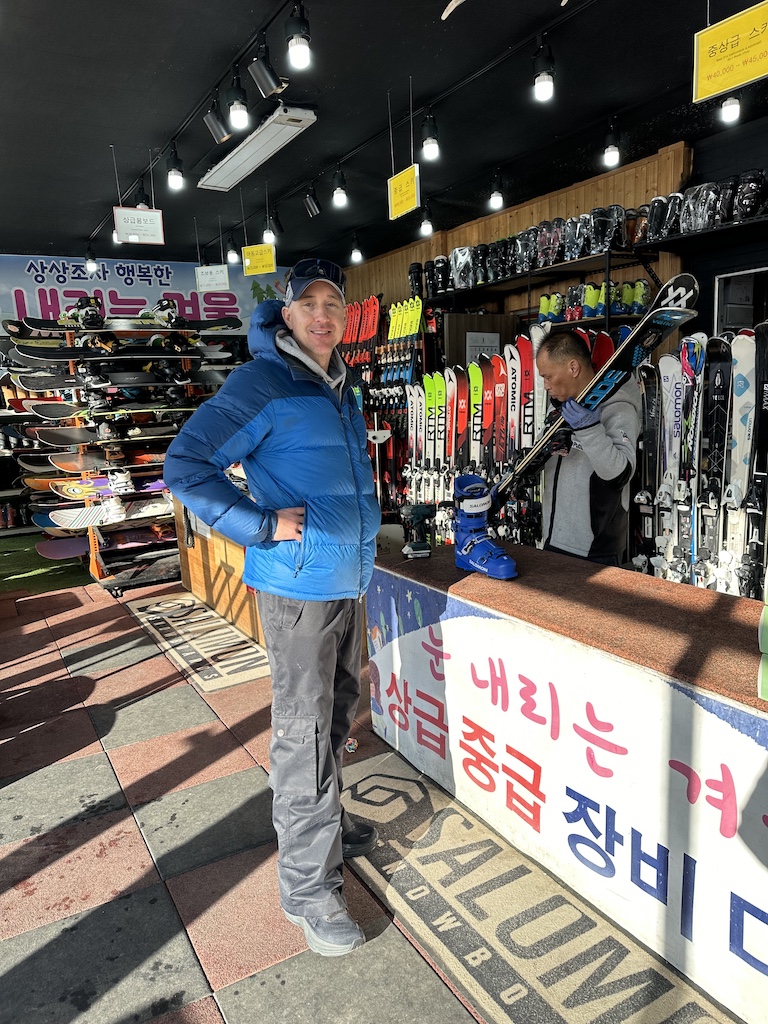
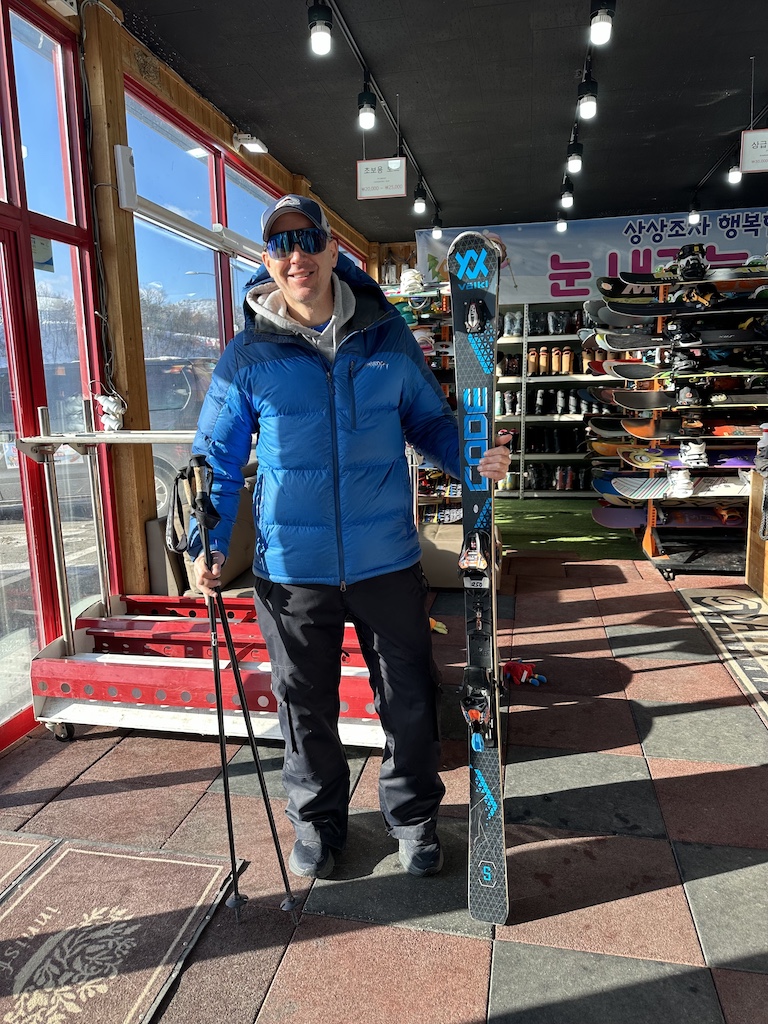
| Feature | Resort Rentals (Dragon Plaza) | Off-Site Shops (Pyeongchang) |
|---|---|---|
| ✅ Convenience | High | Medium |
| 🎿 Gear Quality | Entry-level | Mid to high-end (varies) |
| 💬 English Support | Decent | Limited |
| 💰 Price | Higher | Usually cheaper |
| 📍 Location | On-site | Requires car or taxi |
| 🧩 Bundle Deals | Limited | Often available |
🎒 Lockers, Shops & Gear Tips
If you’re renting on-site, lockers are available inside Dragon Plaza. You’ll also find small gear shops and convenience stores where you can grab goggles, gloves, or a neck gaiter if you forgot something.
A few quick tips:
- Bring your own helmet if you have one — rentals aren’t always included
- Most off-site shops will wax and edge tune their gear on request
- If you’re bringing your own gear, boot bags and day lockers are easy to find and reasonably priced
🏂 Taking Ski or Snowboard Lessons at Yongpyong
If you’re new to skiing or riding, or just want to improve quickly, Yongpyong offers lessons in Korean and English. You can book them directly through the resort or, in some cases, through rental shops in Pyeongchang, often at a discounted rate.
My wife took a beginner lesson here after renting gear from a local shop, and while she speaks Korean, the experience still gave me a chance to observe how things are run.
The instructors were professional, and the Red and Silver Zones offer a mellow, confidence-building environment for first-timers. Even without strong English skills, most instructors are used to working with international visitors.
📚 Booking Tips
Through the resort: You can book full-day and half-day ski or snowboard lessons directly on the Yongpyong Resort website, with options for private or group sessions. That said, the booking process can be confusing for non-Korean speakers, and payment often fails on foreign cards.
Off-site rental shops: Some shops in Pyeongchang offer discounted lesson + gear rental packages, but English support may be limited.
👉 Just need a beginner-friendly lesson you can book in English?
Check out this Yongpyong Ski/Snowboard Lesson package on Klook. It’s easy to book with a foreign card and works well for travelers already staying near the resort.
👉 Looking for a private English-speaking instructor?
This Yongpyong Private Lesson with English-Speaking Instructor is ideal for families, couples, or solo skiers who want a more tailored, high-touch experience.
👉 Want the full package with gear, lift ticket, private lesson, and transport from Seoul?
This Premium Private Ski Tour on Viator includes everything: lesson, equipment, lift pass, and round-trip transportation from Seoul. A solid option if you’re flying in and want a seamless day trip.
📝 English-speaking instructors are limited, especially during holidays and weekends. Reserve early if you’re visiting during peak season.
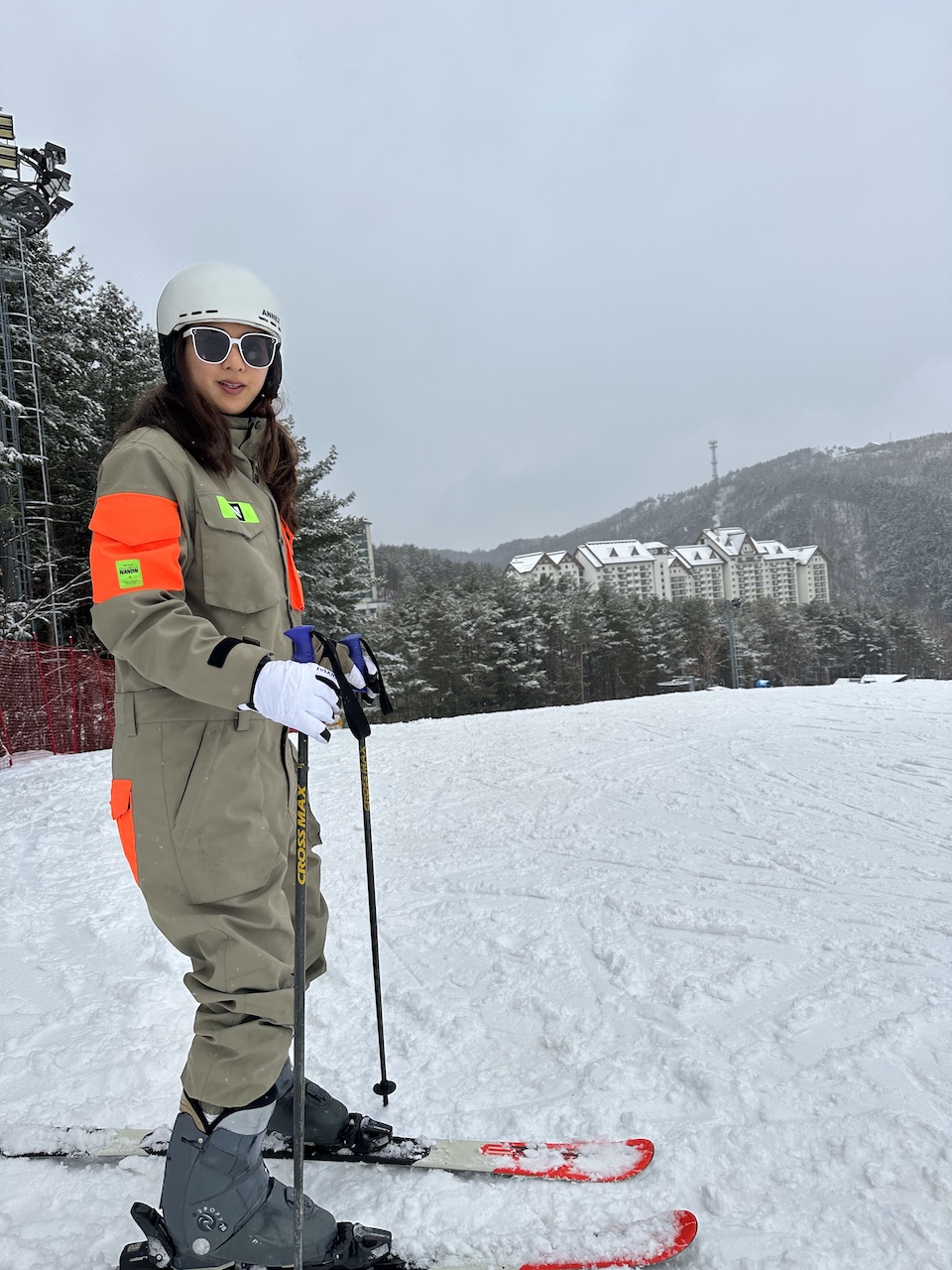
🏨 Where to Stay Near Yongpyong Resort
When choosing where to stay for a ski trip to Yongpyong, I’m always balancing proximity to the slopes, overall comfort, and whether they’ll let us bring our border collie (not always easy in Korea). Below are my top recommendations based on firsthand experience, pet-friendliness, and what’s most convenient for travelers.
🐾 Ramada Hotel & Suites by Wyndham Pyeongchang (Dog-Friendly Favorite)
If you’re traveling with a dog, especially a medium or large breed, Ramada Pyeongchang is my go-to. It’s one of the few hotels in the area that officially accepts pets over 10 kg, and the overall vibe is relaxed, modern, and comfortable.
We’ve stayed here many times with our border collie, and the experience is always smooth. Rooms are western-style, there’s plenty of space to walk your dog, and the views out over the valley are a nice bonus.
It’s also right next to Soon Su Sheep Farm, one of our favorite spots for a slow morning. We’ll grab coffee at the café (big windows, sweeping views), then walk the loop trail that winds through the hills and animal pens. There are a few feeding stations and great photo spots too.
Why I Recommend It:
- Designated pet-friendly rooms with bowls, pads, and potty trays provided
- Dogs allowed up to around 20 kg (check restrictions)
- Quiet first-floor rooms for easy outdoor access
- Close to town but still tucked into a scenic, peaceful area
- Easy parking and sometimes a shuttle to Yongpyong
- Popular with groups, athletes, and international travelers visiting for ski events or sports competitions, not just for pet owners
Things to Know:
- Dogs typically can’t be left unattended in the room
- You may need to show proof of rabies vaccination
- Pet rooms book up fast, especially on weekends
Related Reading: Year-Round Trekking and Camping in Daegwallyeong, Gangwon-do

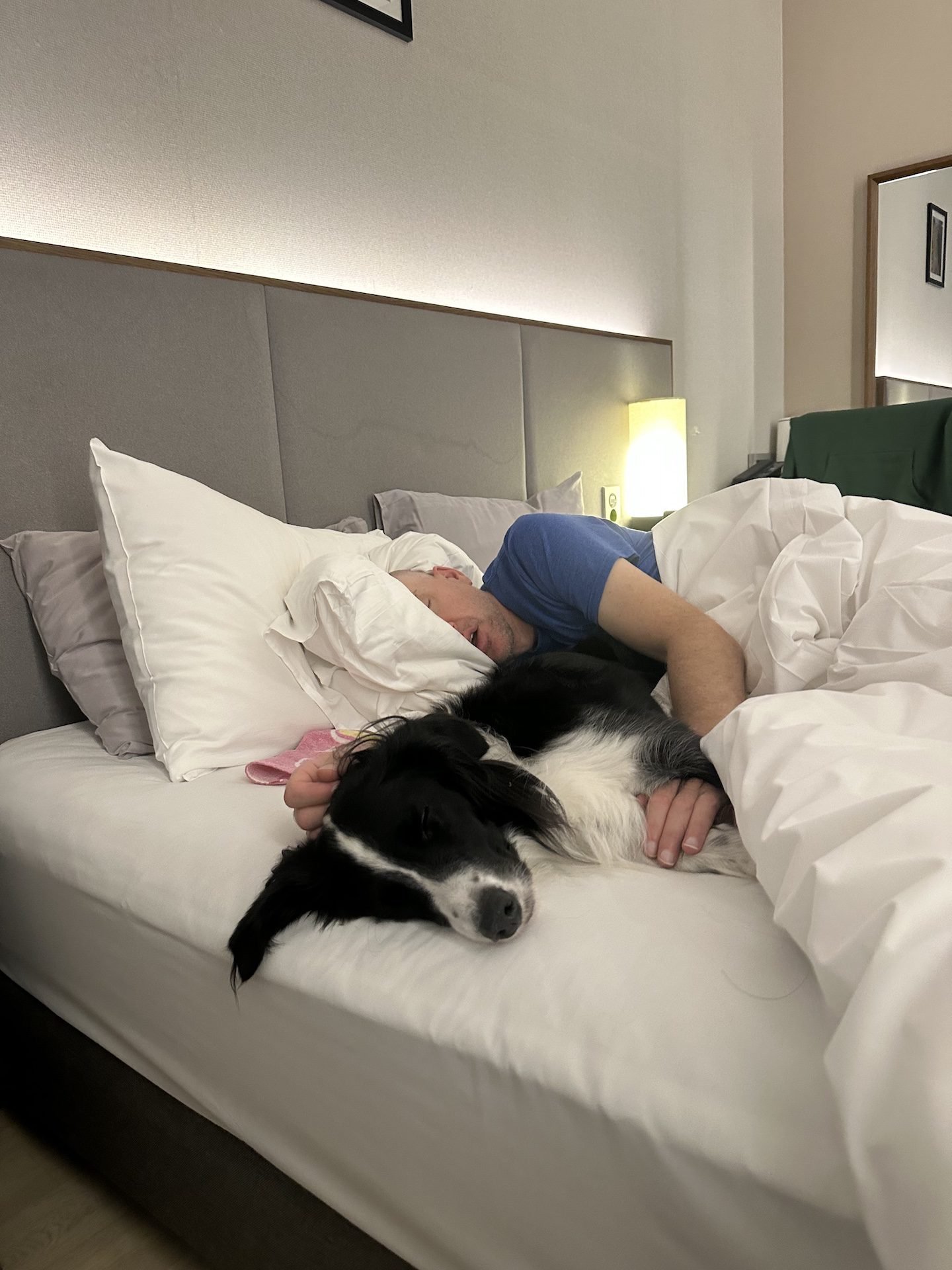
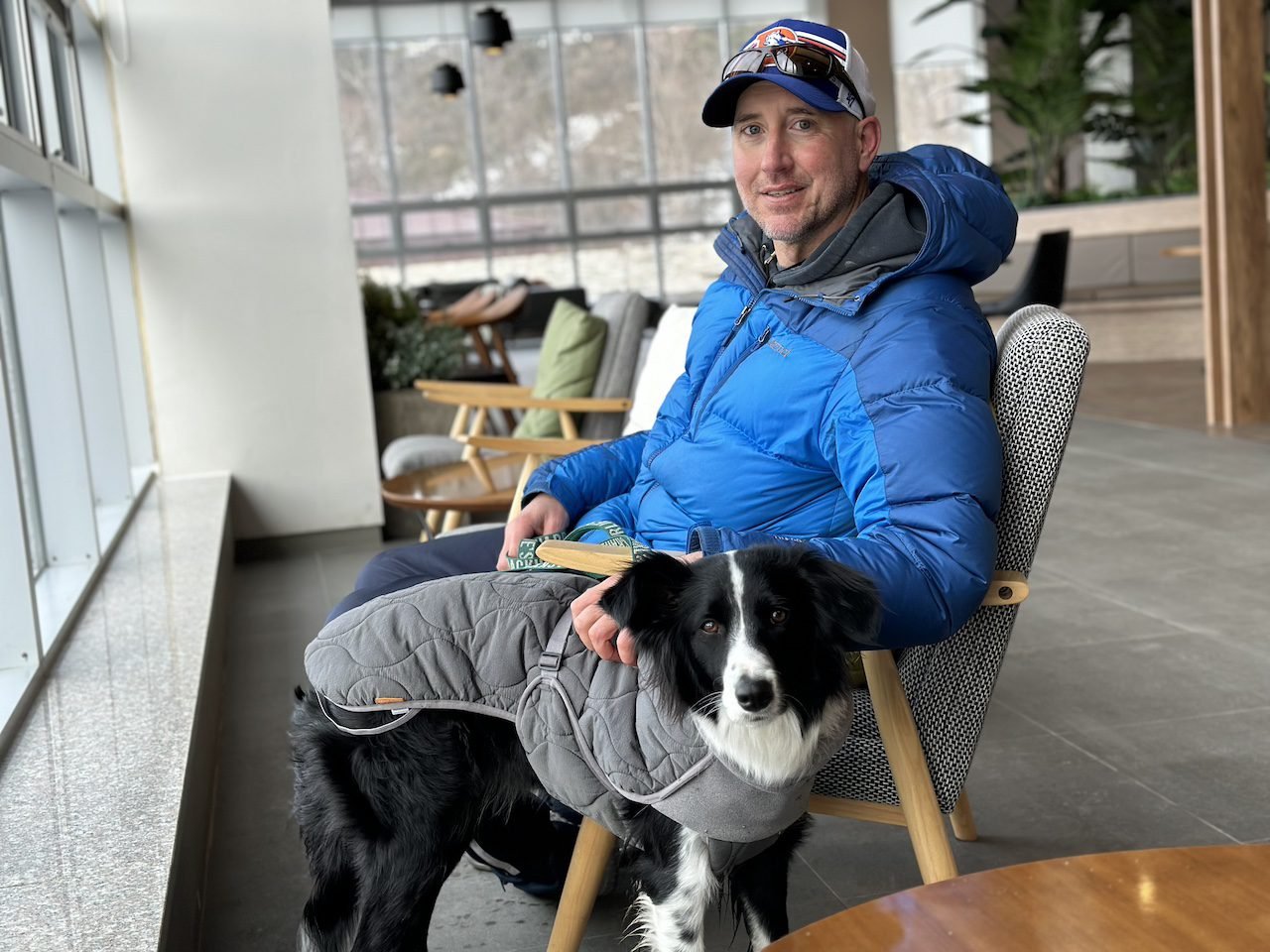
🏔️ Staying On-Site: Mona Yongpyong Resort Lodging
If you want ski-in/ski-out access or just don’t want to drive, Mona Yongpyong Resort offers several on-site lodging options at the base of the mountain.
The most convenient choice is the Dragon Valley Hotel, located right next to Dragon Plaza. It offers both Western-style rooms and Korean ondol setups, making it a good fit for couples or small families.
For larger groups or those wanting more space, Mona Yongpyong also includes condo-style buildings like Tower Condo, Greenpia, and Villa Condo. These units typically offer small kitchens, basic living areas, and futon bedding, making them popular with families or those staying multiple nights.
Pros:
- Walkable to the slopes, lifts, rentals, and restaurants
- Multiple room styles across several buildings (hotel + condo formats)
- Access to on-site amenities like spa, gear shops, water park, and cafés
Cons:
- Not pet-friendly
- Some rooms (especially condos) may feel dated
- Weekends and holidays often sell out well in advance
🏘️ Other Lodging Options Near Yongpyong
If Ramada is fully booked or you want a different vibe, here are a few more worth checking out:
- Kensington Hotel Pyeongchang – Upscale and well-located, sometimes offers deals
- Holiday Inn Resort Alpensia – Good for families, part of the Alpensia complex nearby
- Local Pensions: The Pyeongchang Riverhill Pension & Daegwallyeong Beautiful Pension are budget-friendly options that offer a laid-back, homely vibes with scenic surroundings. They’re perfect for a peaceful retreat after a day on the slopes.
You’ll also find options on platforms like VRBO, Agoda, or Booking Just make sure to check whether the property is at the base of Yongpyong Resort, in nearby Pyeongchang, or at another ski resort in the region (there are 2–3 others surrounding the area).
🎿 Final Thoughts: Yongpyong Resort Is My Top Pick for Skiing in South Korea
If a friend from Colorado were visiting South Korea and we only had time to ski one resort, Yongpyong would be my pick.
It still offers some of the best expert terrain in the country. The Rainbow Zone delivers long, challenging runs with a low-crowd feel, and the Gold Zone adds fast carving terrain for advanced skiers. Off the slopes, it feels closer to a destination resort than most places in Korea. The Dragon Plaza base has a Western-style ski village atmosphere, and the Rainbow base reminds me of the race training areas I grew up on.
High1 Resort comes in a close second. It may actually be the better all-around mountain with more varied terrain and easier to navigate for intermediates. But for the overall skiing experience, Yongpyong takes the crown (in my opinion). The layout is convenient, and the drive from Seoul (and Daegu where I live) is straightforward without steep or winding mountain roads.
👉 Still deciding? Check out my full High1 Resort guide where I compare terrain, layout, lift prices, and pet-friendly lodging.
If you’re traveling with a dog, High1 may be the better fit since you can stay ski-in/ski-out at the Hill Condo. At Yongpyong, we stay at the Ramada in Pyeongchang and drive up each morning. For me, that tradeoff is worth it for the skiing.
If you’re looking for the best expert skiing in South Korea, Yongpyong Resort is the place to go.
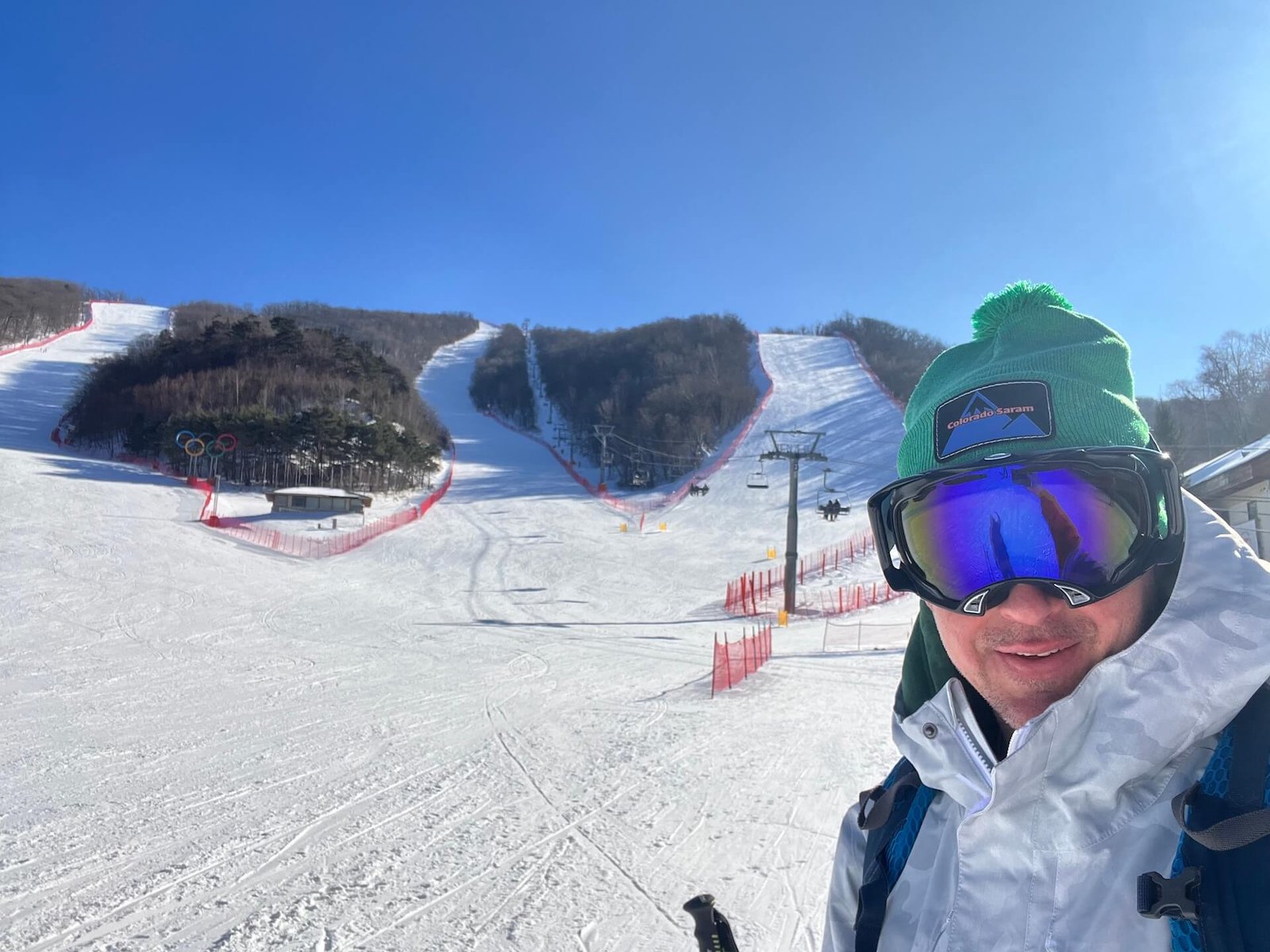
🌞 Summer at Yongpyong Resort
While Yongpyong is best known for winter sports, it’s also a scenic year-round destination.
During summer, the Balwangsan Cable Car runs for sightseeing and gives hikers access to quiet trails, lookouts, and alpine views. There’s even a modern café at the summit with wide open panoramas of the Taebaek Mountains.
If you’re traveling with a dog, there are mellow trails and photo spots near the top that make for a great summer outing.
➡️ Read more: Yongpyong in Summer – Hiking, Gondola & Activities
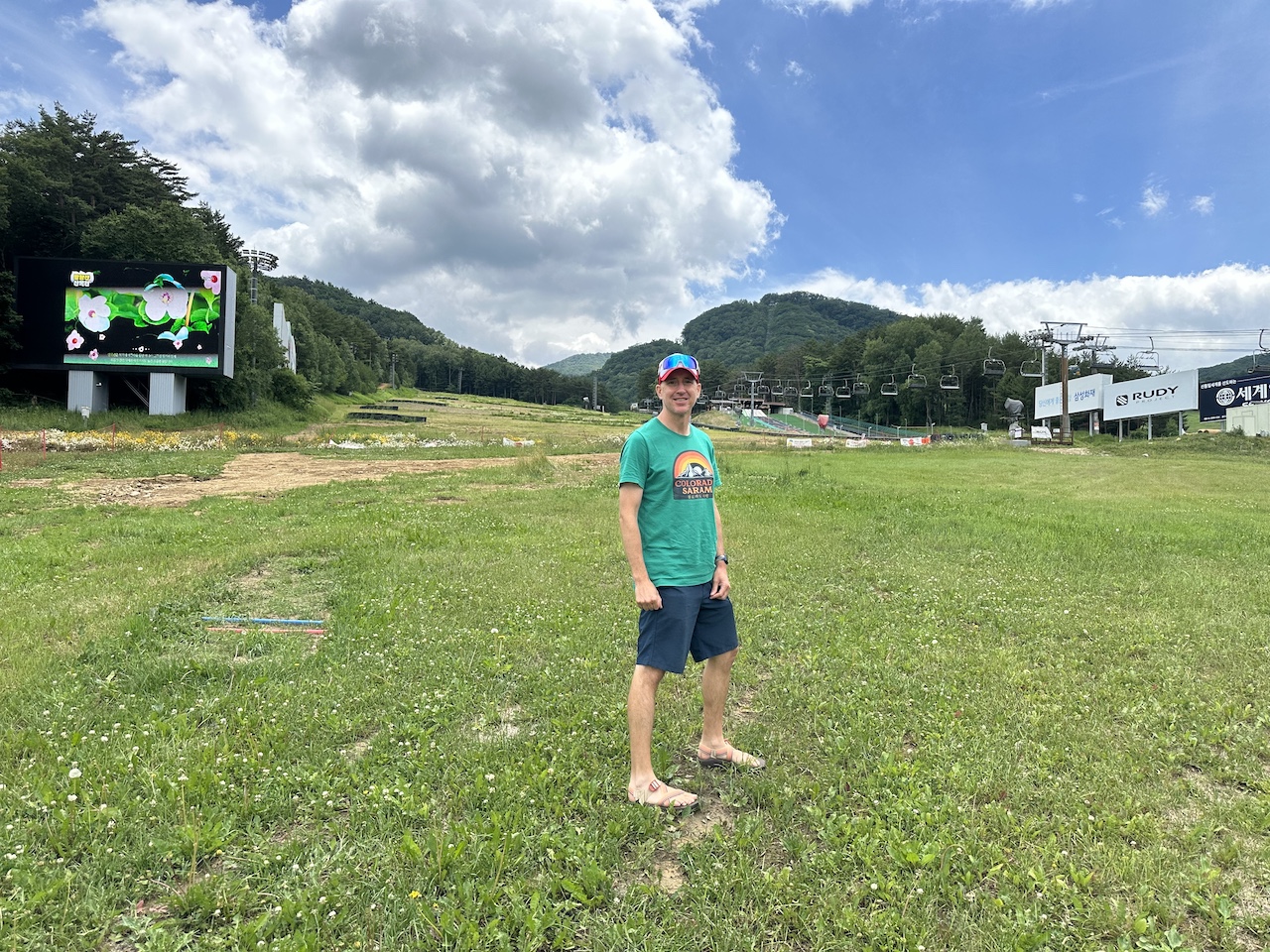
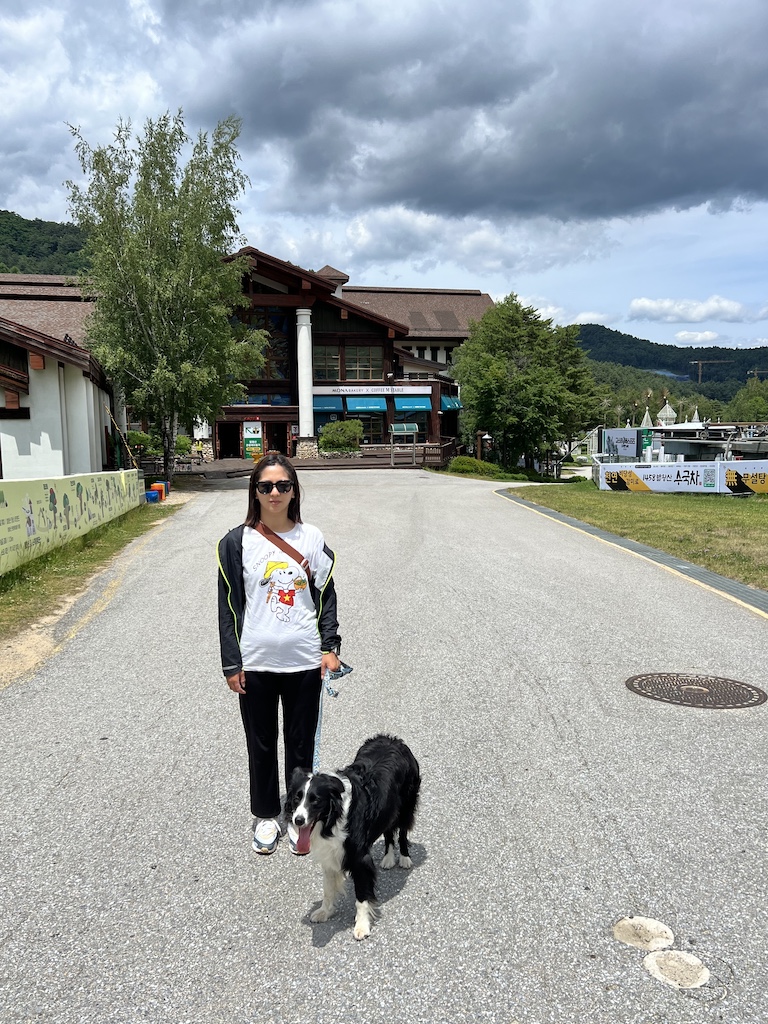
🙏 Support the Blog
This post is not sponsored by any resort, hotel, or brand. Some of the links here are affiliate links, which means I may earn a small commission if you book through them at no extra cost to you.
If you found this guide helpful and want to support the time and travel that go into keeping this site running, you can send a small donation through Buy Me a Coffee using the button below.
It is never expected, but it genuinely helps me keep sharing honest advice and firsthand stories from my ski trips, hikes, and off the beaten path adventures around Asia.
❓FAQs: Yongpyong Resort Travel Tips
Is Yongpyong Resort good for beginners?
Yes, Yongpyong has a large beginner-friendly zone (Silver and Red Zones) with gentle slopes, magic carpets, and lesson options. It’s a great place to learn, especially if you’re staying nearby.
How do I get to Yongpyong Resort from Seoul?
You can drive, take a KTX train to Jinbu Station, or book a direct ski shuttle. From Jinbu, it’s a short taxi or shuttle ride to the resort.
What’s the best run at Yongpyong Resort?
For expert skiers, the Rainbow Zone is the standout. It hosted Olympic GS races and offers long, steep runs with minimal crowds. Beginners will prefer the Silver Zone.
Where can I buy discounted lift tickets?
You can often get better deals through Klook, local ski rental shops near Pyeongchang, or with package tours that include transport and rentals.
Is there night skiing at Yongpyong?
Yes, night skiing is available during peak season and usually runs until 11:30 pm. It’s popular in Korea and worth experiencing at least once.
Are dogs allowed at Yongpyong Resort?
While dogs aren’t allowed on the slopes, you can stay nearby at the Ramada Pyeongchang, which is pet-friendly and just a short drive from the resort.
👉 Niseko vs Rusutsu: Which Hokkaido Ski Resort Is Better for Your Trip?
👉 A 5–7 Day Hokkaido Ski Itinerary
👉 Hokkaido Ski Trip Transportation Guide
👉 Skiing and Travel in South Korea
👉 Beyond Japow: My Search for the Next Great Ski Destination in Asia
🎒 Stay Connected and Keep Exploring
🧭 Need Help Planning Your Trip?
Not sure where to stay, how to compare lift passes, or whether to rent a car? I offer free one-on-one planning support for independent travelers.
This is not a travel agency. It is just me, someone who has been living and traveling around Asia for nearly 20 years, helping fellow snow enthusiasts sort out logistics based on real experience.
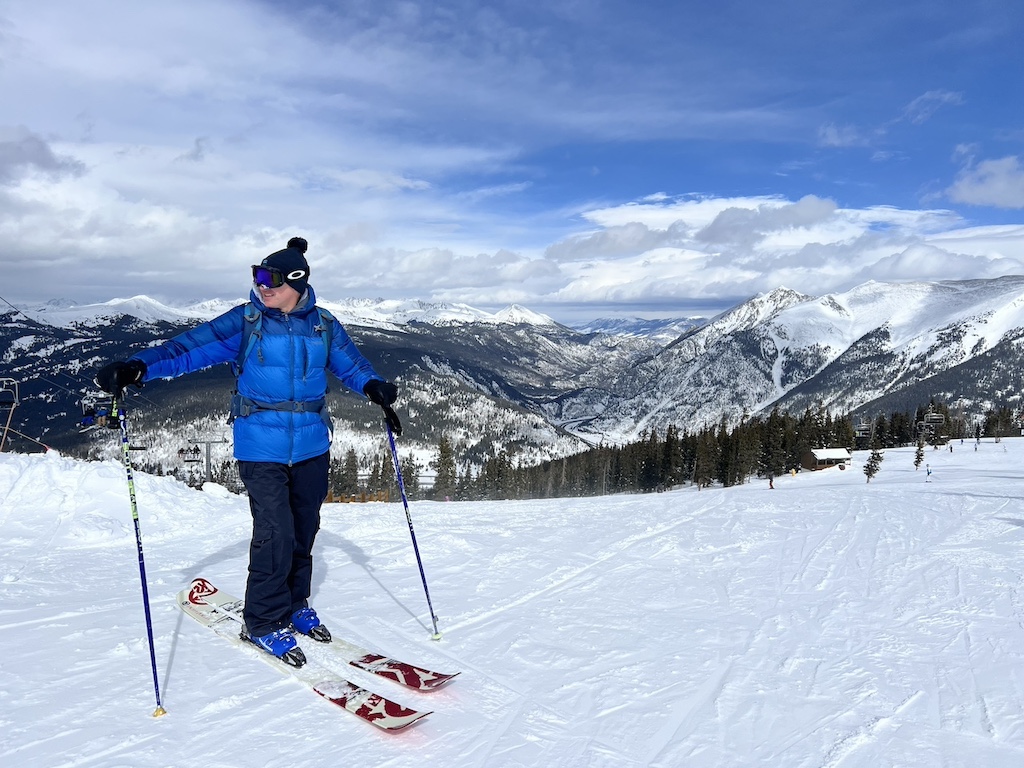
⛷️ Colorado Saram Apparel
Skiing in Korea has taught me two things. The terrain is fun, and the merch options can be limited if you want something that feels true to the mountains here. So I began designing my own Korea themed ski hoodies, shirts, and hats, along with the Japow themed line I created after several trips to Hokkaido.
👉 Visit the Colorado Saram Store
Ski travel comes with real risks. Injuries, lost gear, or weather delays can hit harder when you’re far from home. I always travel with insurance for this reason.
I use SafetyWing because it is affordable, works well for international trips, and covers recreational skiing at marked resorts under the base plan. Emergency medical care, trip delays, and gear protection are included.
If your trip involves sidecountry or backcountry terrain, look into their Adventure Sports add on or a more advanced policy. For most resort days in Japan or Korea, the standard plan does the job.

